I really hope you enjoy this Easy Homemade Japanese Royal Milk Tea Recipe made using only 3 ingredients! If you do, please let me know in the comments below. I LOVE reading your comments ❤
- Why You Will Love This Recipe
- What is Japanese Royal Milk Tea?
- Japanese Royal Milk Tea vs Hokkaido Milk Tea vs Okinawa Milk Tea
- Best Black Tea to Use When Making Japanese Royal Milk Tea
- Japanese Royal Milk Tea vs Indian Chai
- Ingredients & Substitutions
- Recipe & Diet Variations You Can Try
- Step-by-Step Instructions (With Photos)
- Tips
- Serving Suggestions
- Frequently Asked Questions (FAQs)
- Recipe Card
WHY YOU WILL LOVE THIS RECIPE
Hey YOU!
I’m so excited that a drink as delicious as this exists and I’m also excited to share its recipe with you!
Ah ❤… Creamy, rich and luscious with a delicate flavor of tea and a touch of sweetness, this Japanese royal milk tea recipe is happiness in a cup ✨.
Go ahead and meet one of the most popular teas in Japan!
It’s delicious.
And it’s such an easy recipe.
ANDDD it needs only three ingredients too! THREE! Milk, any black tea of your choice (I prefer Assam tea) and white sugar!
Grab a small pot or saucepan, throw these ingredients in and you’re good to go.
It’s also ready in less than 5 minutes.
Can it get any better than this?
If you’re craving a cup of warm tea, you won’t need to wait at all and you’ll have this gorgeous tea all nice and hot in your hands in less than 5 minutes. That’s all! Ready just in time for tea time.
And how do I even describe how good it tastes?
It’s creamy thanks to the fatty whole milk and leans towards being pretty sweet (that’s how it’s supposed to be!) thanks to the sugar.
The creaminess of the milk and sweetness from the sugar help balance out the delicate flavor of the black tea giving us a milk tea that’s creamy and sweet with a gentle flavor of tea.
In royal milk tea, we don’t steep the tea for too long. Because of this, our tea doesn’t taste strong at all.
So yep, I don’t even know what to say, everything just works so well together to bring us a tea that tastes incredible!
Oh and it smells so good too! That gorgeous aroma of tea ❤!!!
Like, I’m not exaggerating when I say it’s one of the best milk tea recipes out there.
I’m so impressed by this Japanese milk tea, you guys.
I found out pretty recently that this tea exists! And I’m so glad I came across it because I love any type of milk tea to bits and pieces.
I mean, I adore tea.
So finding another milk tea recipe that tastes THIS good? It’s amazing! And it’s such an easy recipe too!
Of course, I just had to share this delish tea recipe with all of you. I NEED to!
Oh boy, if you love tea, you’re in for a *royal* treat.
This Japanese royal milk tea has so many good things going for it. Here are a few reasons why you’ll fall deeply in love with it. There are just so many reasons to love it. Like literal, love at first sip ❤!
- This Japanese royal milk tea is a delicious different tea all the way from Japan. A different tea from a different country… a different culture. How amazing is that? To be able to try something that’s so popular in another country out there, right in the comfort of your own home! If you’re into trying different food from around the world, this famous and popular tea recipe is for you! Trying out new recipes is so much fun 💖.
- And if you love Indian chai or fog cutter Irish breakfast tea with some hot milk added in or just milk teas or warm drinks and beverages in general, you’ll love this Japanese royal milk tea! You just need to try it. This tea is like a milder version of Indian chai without the tea being cooked much and also without the spices that Indian chai may sometimes have. You’ll love this if you love tea, so much delishness!
- This Japanese royal milk tea contains a fatty-ish milk and some sugar, yes. But it also has quite some health benefits. First, you have the health benefits from the milk. And then you have the health benefits from the black tea itself that I’ll discuss just a little here. Black tea is filled with antioxidants and lots of good stuff. It’s said to help reduce cholesterol, blood pressure, blood sugar levels and is also said to lower the risk of having a heart attack, heart disease and stroke. Having black tea can also reduce the risk of some cancers. Also, because black tea contains caffeine and an amino acid called L-theanine, it can help improve focus and energy while helping you remain calm and relaxed. Black tea has lots more benefits you can go and read about, just another reason why this royal milk tea is sooo good!
- So I recently had a friend over who had never had milk tea before. The thought of milk tea intimidated her because she hadn’t ever tried it. I made this delicious Japanese royal milk tea for her and she was pleasantly surprised. This popular drink is pretty mild and isn’t strong at all. It’s also creamy, rich and sweet. That creamy richness of milk and delicate flavor of tea 😍. It makes for the perfect beginner tea if you’ve never tried milk tea or even tea ever before. This is a pretty good tea to try if tea is something you want to get into or to try and see how you feel about it. It’s mild, creamy, has a gorgeous gentle subtle taste of tea without being bitter and is on the sweeter side.
- You need only THREE easy to find ingredients to make this delicious cup of royal milk tea. Just some black tea you prefer (I prefer Assam tea, more on this below!), whole milk (or any kind of milk you prefer, the more the fat the better though!) and white sugar (or any other sweetener you prefer). You can find these ingredients at your local grocery store. You may even have some or all of them at home already.
- Craving some nice hot tea? Wanna try a different tea for tea time today? Or have a guest turn up unannounced and want to serve them something that’s delicious and ready real quick? Don’t worry, this tea’s got your back! Because it’s ready in literally less than 5 minutes and is so easy to make too, you’ll have a cup of warm, creamy, delicious tea in no time. Seriously, you just need to put all the ingredients in your saucepan, wait for a couple of minutes and your tea is ready! No need to wait at all. Like it’s such a simple recipe… a super simple tea recipe, the tea is literally ready in under 5 minutes! Plus, because it tastes so good, it’s super impressive to serve to a group of people at a party too. Such an easy and delicious tea to make for a large crowd.
- This is such a nice warm milk tea to sit and relax with when you’re having a tiring day and need a bit of a break. I always look forward to tea time when I’m working. It’s that perfect break drink because it’s so comforting AND refreshing at the same time (if that makes sense!). Also, because black tea contains caffeine, this delicious tea delivers a nice kick of energy too! Win-win 💃🏻.
- This Japanese tea is so versatile. Once you try it and understand how it tastes, it’s so much fun to customize and try different things with it! You can make so many variations of this Japanese milk tea. You can maybe make some cold or iced royal milk tea and go ahead and top your tea with some whipped cream or ice cream? You can add some boba pearls and make it a Japanese royal milk boba tea too (such a good idea!). You can even experiment with different sweeteners such as honey or brown sugar. Once you understand the flavor of this tea, you can customize it however you like! You can work with this milk tea and have so much fun doing it. Go ahead and check our Variations Section below for more ideas on different ways to have this tea.
How comforting are some recipes, right? Would you like to explore more such recipes? Check out our collection of super delicious Drinks & Smoothies, Soups & Stews and Winter recipes.
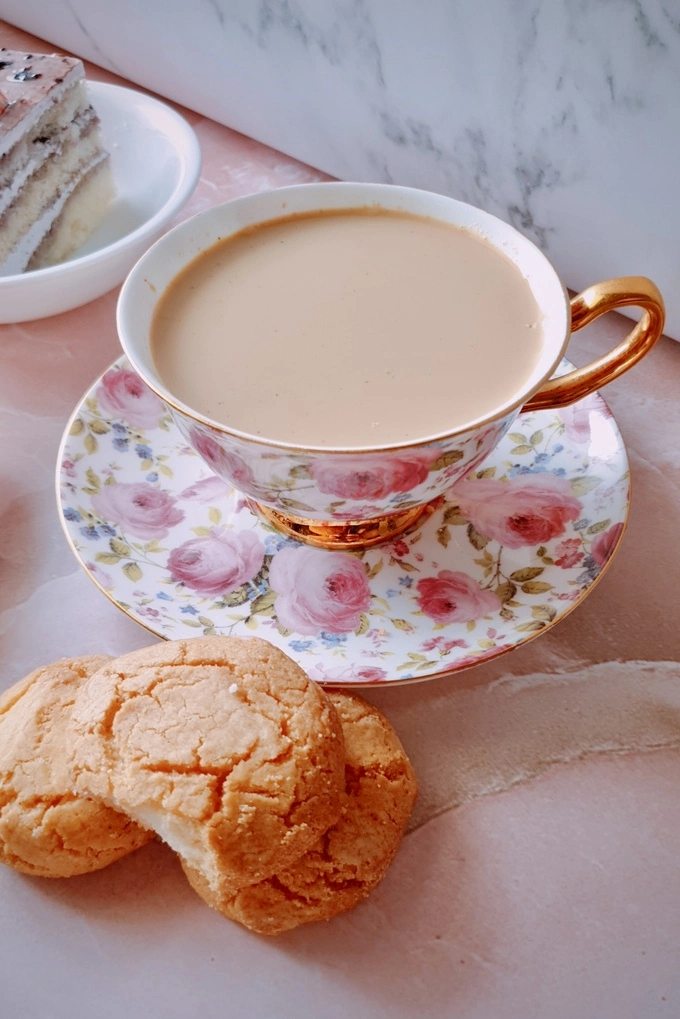
WHAT IS JAPANESE ROYAL MILK TEA AND HOW IS IT DIFFERENT FROM OTHER MILK TEAS?
Japanese royal milk tea is one of the best milk teas out there in the whole world! But hey, every milk tea is the best ❤!
Put simply, Japanese royal milk tea is water, black tea and creamy fresh milk cooked together for a really short time, just until it barely comes to a bubble. The milk tea is then taken off the heat and sugar is added to it.
The result?…
A luscious creamy warm drink that’ll make you go whoa wait a second, how the heck does this taste so good?!
Compared to commonly known regular milk tea, Japanese royal milk tea tastes mellower, gentler, creamier and smoother (I just want to keep describing how good it tastes!). It tends to be on the sweeter side as well.
What makes Japanese royal milk tea different is that it is cooked really carefully to keep the flavors of the tea soft and delicate.
The milk, water and black tea are cooked together in a saucepan until it very gently starts to bubble.
We don’t let the tea come to a boil.
That’s why this Japanese drink is so creamy and sweet without leaning towards being bitter. Because we don’t cook the tea much at all.
This also leads to the milk thickening up a bit giving our tea a rich taste.
It’s a super interesting cooking process… pretty artistic and delicate, to get a tea that’s literal art itself ❤.
There are loads of different ways out there to cook Royal Japanese tea.
After lots of research and experimenting (and I mean LOTS!), I felt the method I’ve shared with you guys here is very close to how this tea is actually made, tastes the best and is the easiest!
The most common thing to do when cooking this tea is adding more milk and cooking it for a really short time, just until you get that delicate flavor of tea out.
There are lots of different types of milk teas out there in the world. They all differ from country to country by their method of preparation, taste, ingredients… So much fun for a person who loves milk tea to try as many milk teas out there as possible!
And EVERY milk tea is special in its own way.
So, what makes Japanese royal milk tea different from other milk teas? Lots of things, you guys!
- It’s important to use good fatty whole milk when making this recipe so the tea tastes rich and creamy.
- It has a higher ratio of milk to water. That helps make it nice, creamy and luscious.
- Also, all the ingredients are cooked together in a single saucepan, unlike some other milk teas such as British regular milk tea for example, where the black tea base is first prepared and then milk is separately added to it. Because everything is cooked together, the flavors of the fresh milk and tea mix together really well. Also, the milk thickens up just a little bit as it cooks to give us a delicious creamy mouthful of tea with every sip. That creamy richness of milk… scrumptious!
- Japanese royal milk tea is also cooked for a really short time as I explained earlier, to just barely get the flavors and aroma of that black tea out without making the tea really strong.
- Not just that but Japanese royal milk tea has extra sugar added to it to keep it on the sweeter side.
Royal milk tea is creamy thanks to the whole milk (that creamy richness of milk 😍), has a gentle flavor of tea thanks to us not cooking the black tea much at all and sweet thanks to the sugar. It’s simply… DELICIOUS.
And it’s so gorgeously aromatic I have no words YUM YUM YUM. That smell of tea!
It tastes incredibly nice and hot on a cold day when you want to warm up and watch a movie or just relax as well as ice cold with ice cubes and maybe even some boba pearls on a hot day when you want to feel fresh and cool down a bit (SO refreshing, such a good idea!).
So there you have it, that’s Japanese royal milk tea, a delicious, versatile and absolutely amazing drink.
No words can do it any justice, you need to try this tea for yourself to know what the hype is about because yes, there is a hype and you need to know what it is 😉!
To read what makes royal milk tea different from regular milk tea in even more detail, go ahead and check this out- Japanese Royal Milk Tea vs Milk Tea: A Unique Guide!
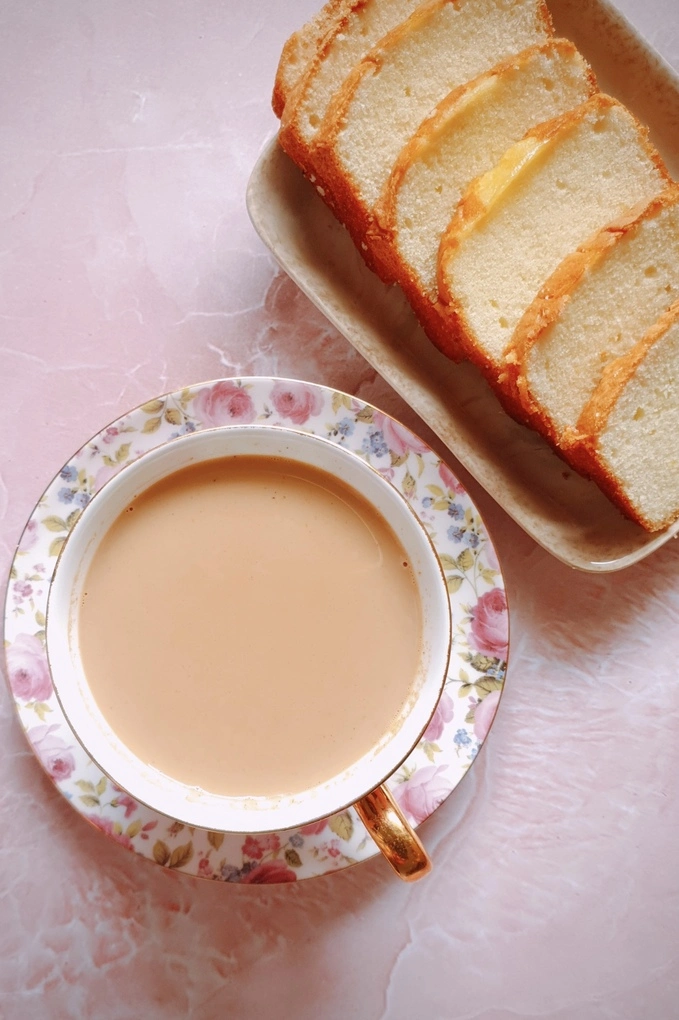
HOW DID JAPANESE ROYAL MILK TEA COME INTO EXISTENCE?
So, how did this gorgeous tea with an equally gorgeous name come into existence?
Japanese royal milk tea came into being in 1965 thanks to the tea company Lipton (if you’re a fan of tea, you’ve definitely heard this name) when they first introduced it in Japan.
Japanese royal milk tea was created to be a part of the “Royal Tea Recipe Series”, the tea company Lipton introduced at that time.
And well, it got super famous really fast, thanks to how incredible and unique it tastes.
This delicious drink is one of the most popular teas in Japan today.
It’s so popular in Japan today that there are companies (such as Kocha Kaden) selling cans and bottles of this gorgeous drink there.
You’ll literally find royal milk tea bottles and cans in cafes, boba tea shops, restaurants, supermarkets and convenience stores (I wish the convenience stores in my country could sell this delicious Japanese drink too ❤!) as well as vending machines in Japan today!
Vending machines in Japan are so cool. And all the different things they’ve got? Absolutely fascinating!
Ah, I hope I can go to Japan one day and try the royal milk tea there (along with every other super cool thing they have in their vending machines!). That would be amazing 😍💃🏻.
People in Japan love this drink so much and it’s such a popular milk tea there, there are literal ready to cook royal milk tea powder versions of this tea sold there that you can just mix in some water and prepare some milky Japanese tea in a single step.
Different flavors of this tea exist in those powdered versions too, such as peach and strawberry. Maybe you can find them if there are any Asian markets near you!
This tea literally has all the makings of a good drink- it’s creamy and on the sweeter side with a delicate flavor of tea. Mmm ✨!
No wonder it’s so loved in Japan and is getting popular really fast around the world today.
That taste of royal milk tea… you’ll just know how good it is the moment you take that first tip.
The cooking method matters so much when you’re making traditional royal milk tea.
That’s because if we cook our tea just a little more, our Japanese milk tea taste may taste strong.
That’s not a bad thing at all BUT milky Japanese traditional tea isn’t meant to taste strong. It’s supposed to have a delicate flavor of tea.
So yes, now, how did I come across this incredibly delicious tea?
It’s personal story time because that’s what The Buttery Fairytale is about, our personal memories with our favorite recipes ❤.
You can share your stories with this recipe in the comments below too whether this is the first time you’re trying this recipe or if you’ve already had it multiple times before, I would love to hear all about it!
Zee and I recently got into bubble tea. Like, literally really really really into it.
We’re in love.
We’ve tried almost every boba place in our city at this point. That’s how crazy we are about it now.
Zee has even sort of learned how to make tapioca pearls.
While reading more about bubble tea and the different types of tea boba pearls are added to, we came across so many different types of milk teas that exist out there in the world, one of them being Japanese royal milk tea.
We just KNEW we had to try it! I mean, it has that pretty name and sounds so… intriguing.
I was like whoa what’s the difference between Regular milk tea and Japanese royal milk tea?
And how does Japanese milk tea taste?!
How does it look?!!
So many questions!
I understood that what makes royal milk tea different is that it uses more milk than water and everything is cooked together in the same saucepan.
It’s not cooked for too long, resulting in a slightly thick, delicate not very strong tea that’s sooo creamy 🤩.
I never even knew tea could be cooked for such a short time like this, I usually make some Indian chai and in that we get everything to a boil multiple times and cook it a little longer to get a nice strong tea taste out.
I would also make English breakfast tea, steeping the tea in some hot water for a few minutes and then pouring in the milk.
But this method of cooking everything together for a really short time sounded pretty interesting.
I went ahead and researched so much to try and get the recipe right.
Lots of fails and lots of “Oh it’s okay but it can be better”… “I don’t think it’s meant to taste like this” happened.
And then one fine day Zee and I tried making it this way, and I squeaked in excitement after that first sip. Zee’s eyes widened in wonder the moment he took a sip too.
The tea was delicious!
We finally found our Japanese royal milk tea recipe!
And of course, we just had to share it with you guys.
We still need to try it with tapioca boba pearls though but going by how it tastes, I’m sure it’ll taste incredible with those delicious pearls in too.
I love tea so much and exploring the different types of milk tea that exist out there has been an interesting experience.
I’ve written about some milk teas I’ve come across too, it’s a pretty interesting read and you can read about some of them here- Japanese Royal Milk Tea vs Milk Tea: A Unique Guide!
There are so many different types of milk tea I still need to try!
So yes, this Japanese royal milk tea tastes incredible and feels incredible to drink too!
It’s literally one of those new recipes that we’ve been making almost every single day at home.
This tea is fit for Royalty. It’s a royal recipe 😉.
Go ahead and make some for yourself the next time those milk tea cravings hit.
Treat yourself, get that beautiful teacup out and feel like Royaltea (!!!) while you sip on this deliciousness.
This tea will be a treat for your tastebuds and that pretty tea in a pretty cup will be a treat for your eyes ❤.
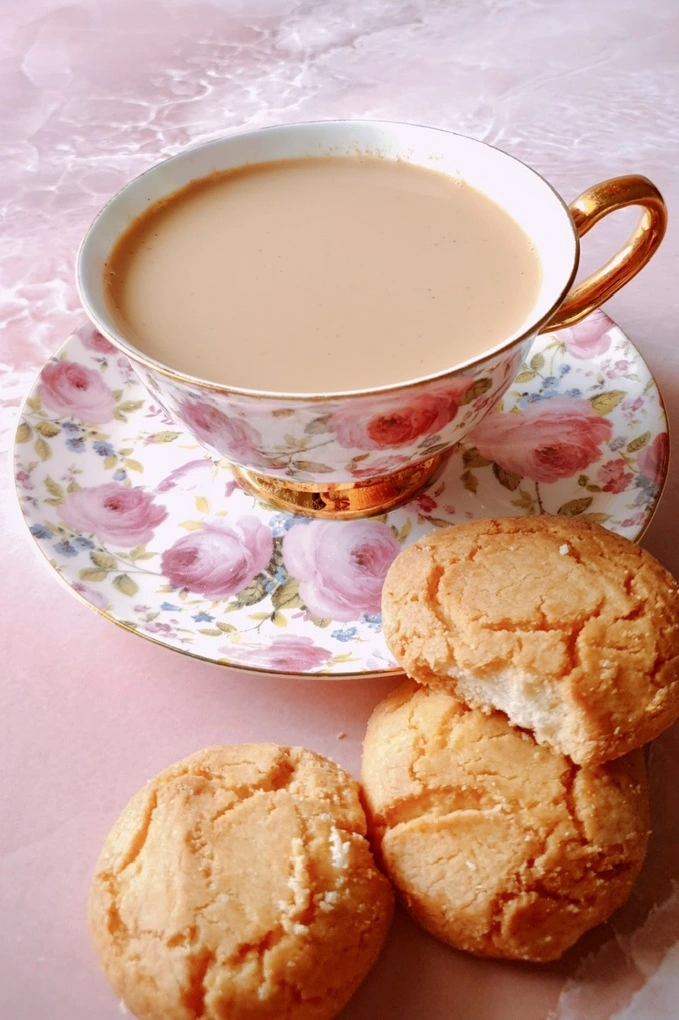
JAPANESE ROYAL MILK TEA, HOKKAIDO MILK TEA AND OKINAWA MILK TEA- WHAT’S THE DIFFERENCE?
I don’t want to confuse you guys but now that you know what Japanese royal milk tea is, you may also want to know that there are two other milk teas out there that are variations of Japanese royal milk tea- Hokkaido milk tea and Okinawa milk tea.
What exactly is the difference between them, you may ask?
Hokkaido Milk Tea:
Hokkaido milk tea uses milk from the Hokkaido region of Japan in the tea along with black tea and a sweetener.
Milk from this part of Japan is called Hokkaido milk and oh man, I heard this milk is super rich and creamy AND is also known to have a very gentle flavor of vanilla.
How amazing is that?! I would love to try some Hokkaido milk RIGHT NOW 😍.
The milk found in the Hokkaido region is really famous and is also said by some to be Japan’s best milk.
This milk tastes so good because Hokkaido has the right weather conditions, sprawling green fields and a pretty good environment for cows to thrive in stress-free.
From what I’ve read during my research, the cows are really happy and relaxed in Hokkaido and that leads to them producing absolutely delicious milk. How adorable is that?
So yes, Hokkaido milk tea uses creamy Hokkaido milk instead of regular milk.
Hokkaido milk tea is known to taste really creamy, sweet and delicious.
It also commonly uses brown sugar as a sweetener.
This tea uses a sweetener called Sanonto sugar which is a light brown type of brown sugar. You can also use brown sugar, demerara sugar, honey or caramel syrup instead.
Okinawa Milk Tea:
Now, Okinawa milk tea, on the other hand, uses a different sweetener along with black tea and regular milk that adds a special flavor to it.
The sweetener is a type of brown sugar called Kokuto which is produced in Okinawa.
Kokuto comes from sugar cane grown in the Okinawa region.
The conditions for sugar cane to grow in there are pretty special, thanks to it being an island having strong sunlight and all the good stuff from the ocean.
Kokuto is also prepared using a very different method and gives a brown sugar that is healthy and tastes rich too. This brown sugar is said to be the healthiest in the world.
Okinawa milk tea is said to taste really rich with a characteristic taste from the Kokuto sugar.
How interesting is it to learn about all this! There are so many other types of milk tea out there in the world and I would love to try each and every one of them 🤩!
WHAT IS THE BEST TEA TO USE WHEN MAKING JAPANESE ROYAL MILK TEA?
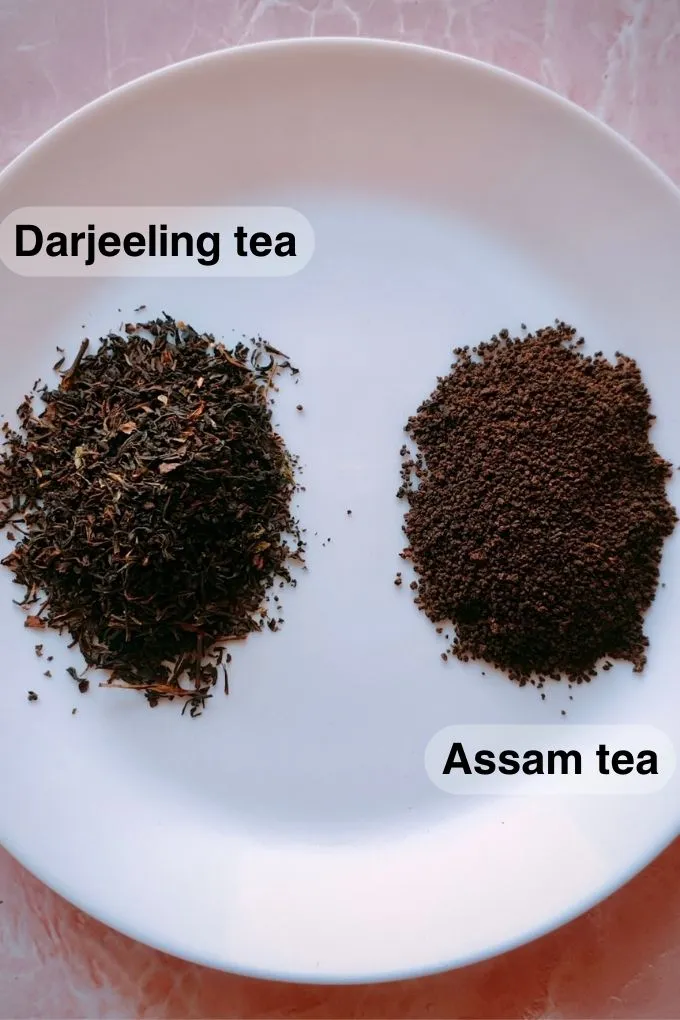
This is a super cool question, a question I too had the moment I came across Japanese royal milk tea.
I was reading about which tea would be the best to use in this milk tea… I came across Assam, Darjeeling and Ceylon teas…So many other types of tea too.
I was so confused because there are so many different types of tea out there… What do I even use 😱?!
So after reading a lot about it, I understood that Japanese royal tea is made using black tea, most commonly Assam tea, Darjeeling tea or both.
So yes, I’ve heard you can use Ceylon black tea, English breakfast tea, Scottish breakfast tea, Irish breakfast tea, Earl Grey tea or even Oolong tea.
I’ve heard of people using green tea or white tea too sometimes.
I personally feel black tea is better suited here than green tea or white tea but it all depends on your preference.
I love green tea on its own but I don’t really think it’ll go well with milk here. If you’ve used it and prefer it, lemme know in the comments below!
Assam tea, Darjeeling tea or a blend of Assam tea and Darjeeling tea are the most commonly used black teas in this tea.
It’s really important to use a black tea that’s good quality.
The type of tea matters too. That’s because there’s a higher ratio of milk to water in this tea and also because we cook it for a pretty short time, so we need the tea to have a flavor that’s strong enough to hold its own in a creamy sweet tea such as this one.
So let’s discuss what both these teas do for our royal milk tea recipe:
Assam Tea:
Assam tea comes from Assam, a state in India.
It’s one of my most favorite black teas so I may be biased but oh man it tastes so good.
It also has a delicious aroma to it that IS GORGEOUS.
Assam tea is known to be a strong black tea. The flavor of this tea has been described as being earthy and malty. I personally also feel it has a touch of caramel and chocolate to it too once it mixes in with the milk and sugar.
That rich taste of Assam tea also works really well with the creamy milk and comes out delicate and mellow thanks to the method of cooking.
Since this is a strong tea, mixing it with milk makes the flavor really gentle and helps that delicious flavor of Assam tea really come through beautifully!
It also gives the prettiest color once it mixes with milk in our Japanese tea.
Darjeeling Tea:
Darjeeling tea is grown in the Darjeeling district in the state of West Bengal in India.
This type of tea is an excellent beginner’s tea if you’re new to milk tea or tea in general and are looking to get into it and aren’t used to tea and its rich flavor.
Assam tea tastes really mild in Japanese royal milk tea but Darjeeling tea tastes even milder so you can try this tea out first if you’re new to tea.
The taste of Darjeeling tea has been described as floral, sweet, musky, fruity and citrusy. It smells really good too… flowery and delicate.
I feel it tastes really pretty and has a mild floral flavor to it.
It also has a much lighter color compared to Assam tea.
Oh and Darjeeling tea is known as the champagne of teas as well so that’s a pretty impressive title to carry!
So yes, you can literally use any type of black tea you prefer.
Assam tea and Darjeeling tea are common favorites out there though and the most used teas in this royal Japanese creamy milk tea.
You can try both and see which flavor you prefer. Once you understand the flavor these two teas give, you can maybe make a blend of Assam tea and Darjeeling tea too! It’s all up to you 💖.
Once again, I personally prefer Assam tea because I adore its flavor in this tea.
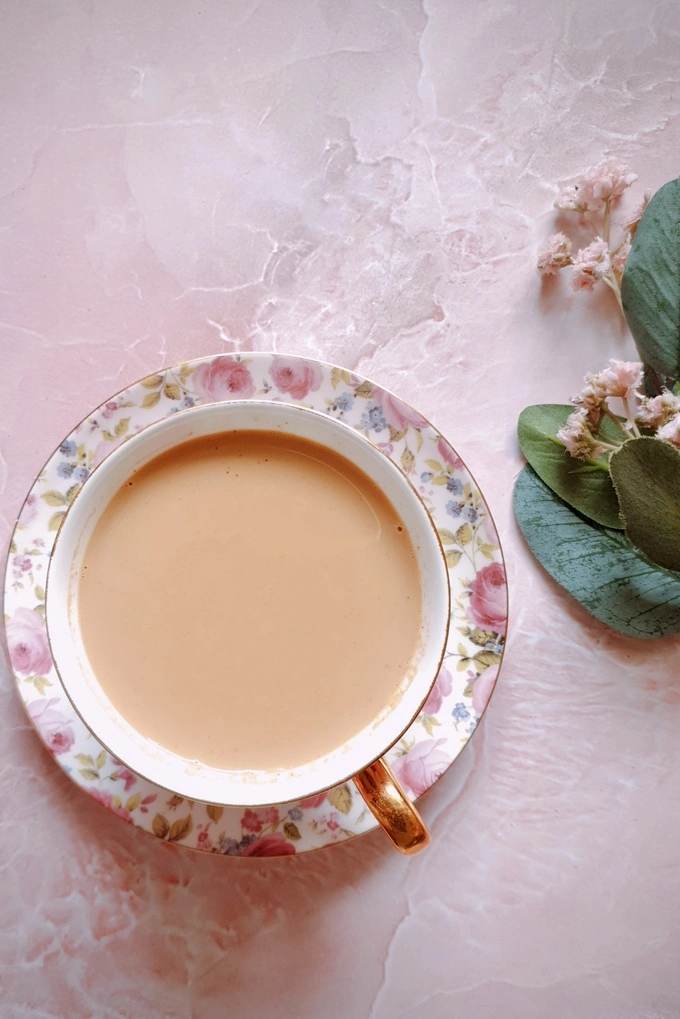
IS JAPANESE ROYAL MILK TEA THE SAME AS INDIAN CHAI?
I’ve seen Japanese royal milk tea being compared so much to Indian chai, saying how the only difference between the two is that there are added spices in Indian chai and I don’t agree.
These two teas taste different and are also cooked differently.
Japanese royal milk tea tastes delicate, creamy and is on the sweeter side.
Since it has more milk in it, it has a delicious creamy texture, is not very strong because we don’t cook the tea much at all and is also on the sweeter side because we add a little extra sugar to it.
Indian chai, on the other hand is stronger, is cooked for longer, doesn’t have much milk in it and may taste different depending on the type of Indian chai you’re having such as ginger chai, masala chai… The different types of Indian chai (and some other milk teas out there) have been explained here- Indian Chai.
Indian chai usually tastes stronger and may be less creamy or sweet depending on the type of Indian chai you’re having.
It may or may not sometimes contain spices too. It’s delicious and not the same as Japanese royal milk tea.
As a huuuge milk tea person, I can tell you guys that Japanese royal milk tea and Indian chai are both cooked by adding tea, water and milk together in the same saucepan BUT that’s where the similarity ends (different people have different methods of cooking both these milk teas but this is one of the most common methods).
The way we cook both these teas once those ingredients are added to the saucepan is completely different as well as how much water and milk we add in both these recipes.
There are a few massive differences between these two. Some are:
- Royal milk tea contains a higher ratio of milk which results in a creamy lush milky tea. Indian chai on the other hand, doesn’t contain as much milk, it may be equal or less than the water added, resulting in a strong robust milk tea that is slightly creamy.
- Japanese royal milk tea tends to be on the sweeter side and Indian chai on the other hand may or may not be really sweet. The chai you get at restaurants and tea shops in India sometimes tends to be on the sweeter side.
- Japanese royal milk tea and Indian chai are both cooked in the same saucepan. There are different methods different people and restaurants follow when making both Japanese royal milk tea as well as Indian chai. Sometimes the tea is cooked first and then milk is added to the saucepan and then everything is cooked for some more time. Sometimes the milk, tea and water are all added together and cooked (like we do in this recipe). The main thing here is that in Indian chai, the tea is cooked for a much longer time than in Japanese royal milk tea to get a stronger taste of tea. In Japanese royal milk tea, we don’t let our tea reach a full boil at all, the moment it reaches an almost there boil, we switch the heat off, to keep the taste of tea as gentle as possible. Whereas in Indian chai, we let all our ingredients come to a boil multiple times and we cook the tea for a longer time to make the chai stronger.
- Indian chai may contain spices and is pretty well-known for that in the world. Not every Indian chai contains spices though. A type of Indian chai, known as masala chai contains spices. Japanese royal milk tea, on the other hand, is not known to contain spices.
- Japanese royal milk tea has a beautiful delicate light color because it’s cooked for a short time and also because it has more milk added to it, especially if you’re using Darjeeling tea instead of Assam tea. Indian chai on the other hand has a gorgeous dark color because it’s cooked for longer and also because not as much milk is added to it.
Phew! Just wanted to make things clear for you guys. Hope this helped ❤!
INGREDIENTS & SUBSTITUTIONS FOR EASY HOMEMADE JAPANESE ROYAL MILK TEA RECIPE MADE WITH ONLY 3 INGREDIENTS
For exact ingredient measurements, please scroll down to the Recipe Card.
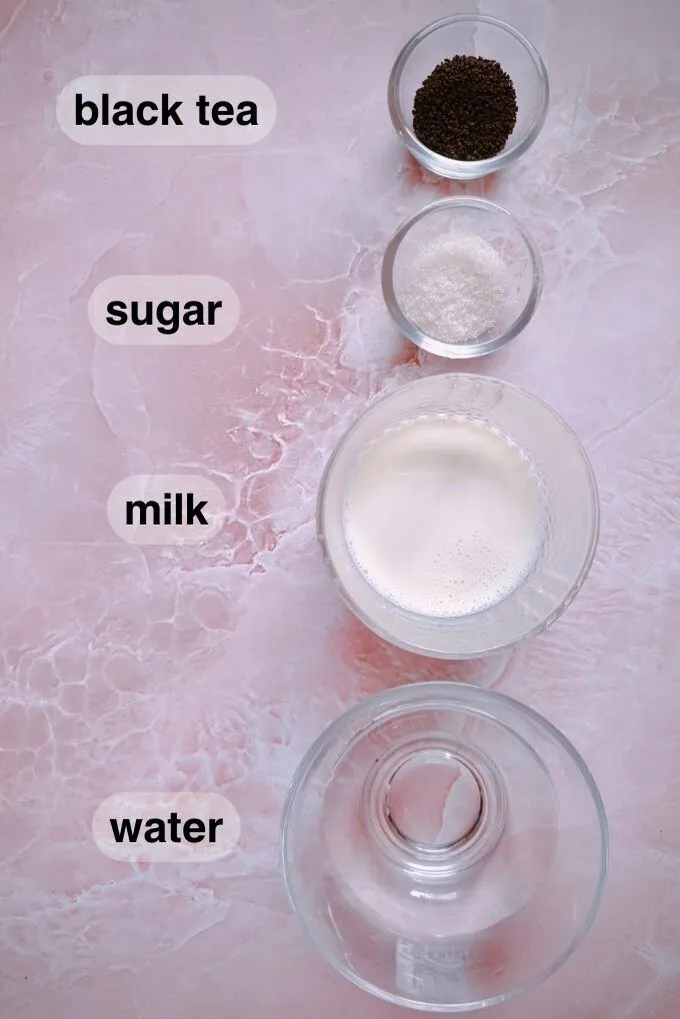
- Water– Go ahead and use good old water.
- Milk- The type of milk you use here is really important and whole milk is really the way to go. When you’re making Japanese royal milk tea, using fresh milk that’s thick, creamy and filled with fat is the best choice. That’s because milk adds to the creaminess of the tea here. It gives the most delicious creamy texture to our tea. The fattier the milk, the better. You can literally go ahead and use half and half or even add in some sweetened condensed milk to make the texture of your milk tea even creamier for a thick milky creamy base. I suggest you don’t use skim milk or low-fat milk if you want that creamy texture in your Japanese milk tea. If you don’t mind not getting a really creamy milk tea, you can go ahead and use skim milk or low-fat milk. You can substitute with any milk you prefer here but it may not be as creamy. I’ve heard oat milk and cashew milk are good plant-based substitutes! You can also use a lactose-free milk that you prefer and you know is on the creamier side.
- Black tea- Assam tea and Darjeeling tea are popular choices when it comes to Japanese royal milk tea. Make sure you use good quality black tea because this is a sweet milky drink where the tea isn’t cooked for really long. Because of this, the tea needs to be strong enough to hold its own. A good quality black tea that’s strong adds so much goodness to the flavor of this hot drink. Once you understand how these two black teas taste (or any other black teas too), you can go ahead and blend different black teas (such as a blend of Darjeeling and Assam tea) together to create a tea flavor that’s unique to you! To read more about what black tea between Assam and Darjeeling tea is right for you to make the best Japanese royal milk tea ever, go ahead and check this out above.
- Sugar- Royal milk tea is supposed to be on the sweeter side. A good sweetener brings the creamy milk and gentle tea together to give us a gorgeous drink! It’s a wonderful mix of different flavors. Don’t worry though, you can add as much sweetener as you prefer. I’ve used white sugar here but you can substitute it with any sweetener of your choice such as caramel syrup, brown sugar, honey, sweetened condensed milk… whatever you prefer! Please keep in mind that the sweetener you use will influence the flavor of your royal milk tea.
Once again, for exact ingredient measurements, please scroll down to the Recipe Card.
How comforting are some recipes, right? Would you like to explore more such recipes? Check out our collection of super delicious Drinks & Smoothies, Soups & Stews and Winter recipes.
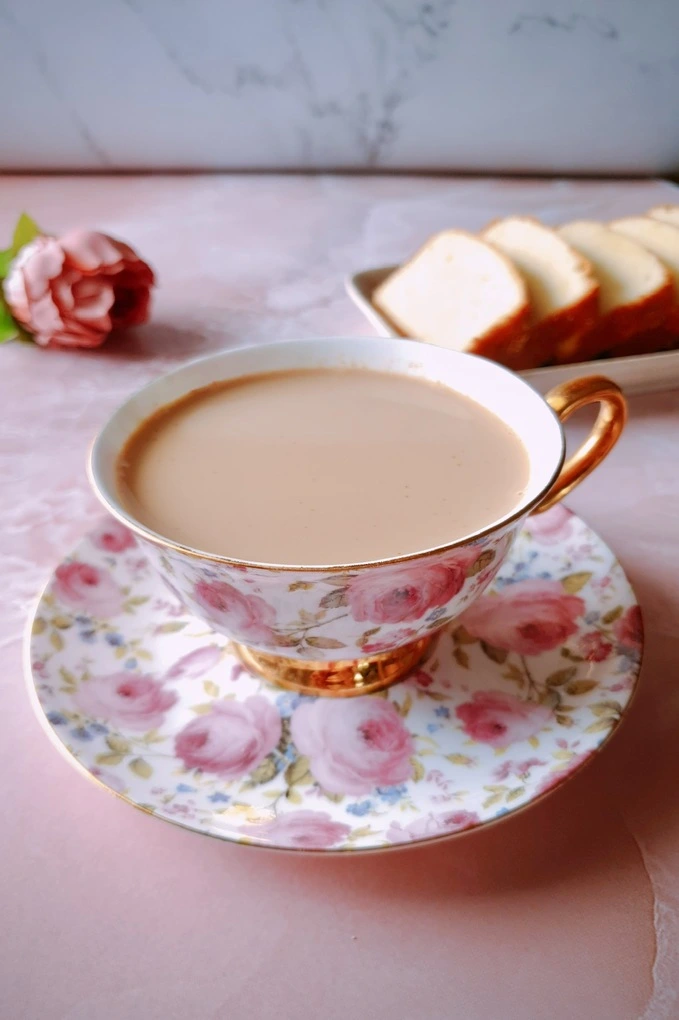
RECIPE & DIET VARIATIONS YOU CAN TRY
As I’ve already mentioned, this milky Japanese tea is so versatile.
Once you understand the flavors of this tea, you can work really well with it to create absolutely incredible easy creamy milky tea combinations and have so much fun doing it too!
You can literally customize it however you prefer because that’s just how good it tastes and goes along with so many other ingredients.
Let’s discuss a few variations you can try with this delicious delicious DELICIOUS ❤ tea!
- One of the main ingredients that make this tea taste so ✨ fine ✨ is some good whole milk. That creamy richness of milk is one of the best things ever about this recipe! A nice fatty milk adds so much to this tea and is literally one of the main features of this hot Japanese drink. You can use some fatty whole milk as I’ve mentioned or maybe even half and half for an even richer creamier taste. You can also maybe use evaporated milk/unsweetened condensed milk along with whole milk to add to that thickness and creaminess. You can go ahead and use your favorite lactose-free or plant-based milk that you feel is nice and creamy too (check below for dairy-free and vegan options).
- I sometimes feel like adding some fun to my warm Japanese royal milk tea so I go ahead and top it with a nice fat layer of frothed milk. You can do the same to add to that delicious creaminess. The milk stache just adds to the experience :’D. If you’re feeling even more indulgent and feel like pampering yourself a bit, go on and top your decadent warm royal milk tea with some whipped cream. Ah ❤
- Because this popular drink is supposed to taste rich and creamy with a gentle flavor from the black tea, we barely cook our tea at all so those black tea flavors don’t get really strong and dominate over our tea. But hey, if you prefer a stronger tea, you can go ahead and cook your tea for a longer time. The longer you leave your tea to cook, the stronger it’ll taste. You can also choose to use Assam tea if you prefer strong tea. This type of black tea has a pretty strong flavor especially when cooked for a long time.
- Now, if you want your Japanese royal milk tea to have an even gentler flavor, just go ahead and cook it for an even shorter time, like before it starts to gently bubble and is just heated through in your opinion. If you want your tea to be delicate with a gentle flavor of tea, go ahead and use Darjeeling tea.
- When it comes to a tea that tastes as delicate as Japanese royal milk tea, the addition of different types of sweeteners can change the taste of this tea quite a bit! You can go ahead and experiment with different sweeteners out there and see which ones taste best for you. Try adding your favorite sweetener in and see how this tea then tastes. Do keep in mind though that any sweetener you add may change the taste of your creamy tea! A few ideas are sweetened condensed milk (for some even creamier sweet goodness), caramel syrup (for a sweet rich smooth flavor), honey (for a sweet silky floral touch! Please keep in mind that the flavor of honey is important here and will change the flavor of your tea too!), brown sugar (for a delicious candy toffee-ish taste. You can make some brown sugar syrup for even more richness). You can also use maple syrup, coconut sugar, agave… you can make some sugar syrup as well using any sugar you prefer.
- A famous brand in Japan sells ready to make Japanese royal milk tea powder. It sells this delicious milk tea powder in flavors such as peach and strawberry. You can make a sweet fruit syrup to add to your royal milk tea for sweetness and a fruity flavor as well. You can buy a fruit syrup or make your own fruit syrup at home using your favorite fruit and just add it to your royal milk tea once it’s ready! You can make some fruit syrup using maybe strawberries and make a strawberry royal milk tea? Or a mango royal milk tea? Oooh the possibilities 🤩!!!
- If you want to skip out on using a sweetener, you can try and see how you like the taste of this tea without a sweetener. When it comes to a milky creamy tea like this where the tea isn’t cooked for really long, it won’t taste really bitter and also, thanks to all the milk we add to it too, it’ll be super creamy. You can skip out on a sweetener and see how you like the taste.
- I know I’ve been going on and on about what an amazing comforting warm drink Japanese royal milk tea makes but the best part about this Japanese drink is that you can have this drink cold too! This popular drink makes for an absolutely delicious and refreshing cold tea. You can wait for the tea to come to room temperature and then add some ice cubes in and make it an iced Japanese royal milk tea as well! There are actual chilled cans and bottles of royal milk tea sold in vending machines in Japan. You’ll even get iced or cold versions of royal milk tea boba. This beverage works super well hot, cold and iced! Is there anything it can’t do ❤?
- Make your cold or iced royal Japanese milk tea even fancier by topping it with some ice cream or whipped cream or both! It’ll add to the already existing creaminess and richness of this Japanese drink. To make it even fancier, go ahead and pour some delicious caramel syrup into your tea instead of sugar, then top the tea up with some whipped cream or ice cream or both and then top everything up with some more ribbons of caramel sauce or syrup! YUM! This adds so much more indulgence and creaminess to this creamy milky tea.
- You can add to the flavor of this Japanese royal milk tea and make it taste even richer by adding in a few strands of saffron to the tea while it cooks. You can also add in a few whole spices while the tea cooks such as cloves, cardamom, cinnamon… to get that slight earthy flavor that Indian chai has but in a really mild form here because here we won’t be cooking our tea much at all. We’ll get in just a hint of flavor of these spices without them being really strong. You can also just add in some ginger too while the tea cooks for added flavor because it goes so well with milk tea. These extra ingredients will add to the health benefits and taste of this tea.
- You can try making Hokkaido milk tea too which is a variation of Japanese royal milk tea found in the Japanese prefecture, Hokkaido. Hokkaido tea uses Hokkaido milk in its tea which is a deliciously fatty milk with a slight hint of vanilla (oh my goodness how amazing does that sound 🤩?!). It’s pretty difficult to find Hokkaido milk outside Japan. If you happen to have any with you after a recent visit, you can use it OR you can go ahead and try making something close to it. Just take a good full-fat milk, you can add some cream to it too to make it even fattier. Add a small drop of vanilla extract or just a little vanilla bean paste to it, mix everything well and cook your tea according to our recipe here! This tea also usually uses a sweetener called Sanonto sugar which is a light brown type of brown sugar. You can also use brown sugar, demerara sugar, honey or caramel syrup instead.
- You can also try making some Okinawa milk tea. This is another variation of Japanese royal milk tea found in the Japanese prefecture, Okinawa. This tea uses a delicious sweetener called Kokuto sugar. This is a type of brown sugar produced in Okinawa and has a pretty distinct taste. If you don’t have some Kokuto sugar at home because it may not be easy to find, you can use brown sugar, palm sugar or toast your sugar a little and add it to the tea you’ve prepared according to the recipe given here.
- Since this is a milkier tea, the creamy flavors of it go super well with some tapioca pearls. Just go ahead and add some boba pearls to this rich tea and make it a Japanese royal bubble milk tea ❤ Ah, bubble tea is one of the best things in the whole world.
- Lots of people adore the color of tea. I for one love the color of Indian chai, it’s one of the prettiest colors ever. Some people also prefer to have the color of their drink be lighter or darker depending on the type of drink they’re making and the look they’re going for. If you would like to go for a lighter colored Japanese royal milk tea, go ahead and use some Darjeeling tea. The tea will be a light very pretty creamish-light brown color. If you want a darker colored Japanese royal milk tea, go ahead and use Assam tea. The color will be a beautiful lightish-medium brown and will darken the more you cook it.
- Continue reading if you would like to read about dairy-free and vegan adaptations of this Japanese royal milk tea recipe.
Note- If you think you have an ingredient that you feel is suitable as a substitute for a certain ingredient in this recipe, according to your dietary preference, you can use it and let us know how it works as a substitute in the comments below. I’ll then add it in as an adaptation suggestion here. This will help so many others with the same diet preference as yours.
Dairy-Free Adaptation:
To make some creamy dairy-free Japanese royal milk tea, keep in mind that there are lots of milk alternatives out there that you can use.
If you already have a favorite type of plant-based milk that you use when you’re making coffee or tea, go ahead and use that one or experiment with different plant-based milks out there.
I’ve heard oat milk is a good substitute because it is pretty creamy and a creamy milk is exactly what you need here. I’ve heard cashew milk works pretty well here too.
You’ll know what works for you if you try so go ahead and experiment.
What type of milk do YOU prefer? Let me know down in the comments!
Always make sure to read through the ingredient list of all the ingredients to make sure they are dairy-free because hidden dairy may be present in some ingredients.
Vegan Adaptation:
To make some delicious vegan Japanese royal milk tea…
- If you already have a favorite type of plant-based milk that you use whenever you make a yum cup of tea or coffee, go ahead and use that one. If you don’t have one, just go ahead and experiment with different plant-based milks. I’ve heard oat milk is a pretty good substitute because it is pretty creamy and that creamy texture is exactly what we need here. I’ve also heard cashew milk works pretty well too. There are so many other options as well such as soy milk, almond milk and many others. The more you experiment with different plant-based milks, the sooner you’ll understand which one you prefer and find your fave one! If you already have a favorite, please let us know in the comments below. It’ll help so many people out there!
- Sugar is not vegan because it is usually refined in a process that involves bone char. To sweeten your delicious vegan milk tea, you can experiment with different sweeteners and see which one you prefer best. That’s because each sweetener will add its own unique taste to your vegan Japanese royal milk tea. You can try a type of vegan sugar you prefer, maple syrup (make sure it’s 100% vegan though), coconut sugar, agave syrup… there are loads of wonderful options out there!
Please make sure you always read through the ingredient list of all the given ingredients in the recipe to be sure that everything is vegan.
Disclaimer– I’ve done research to make things easier for you guys, but please make sure you do your own research too if you are allergic to something or have a specific diet preference. The suggestions given above for dietary preferences are only suggestions and NOT medical advice. These are suggestions given just after a little research on the said dietary preferences. We are NOT trained medical professionals or nutritionists. You are responsible for yourself, so please ask your physician if you have any questions and make sure you always completely read through the ingredient list of any ingredients you use.
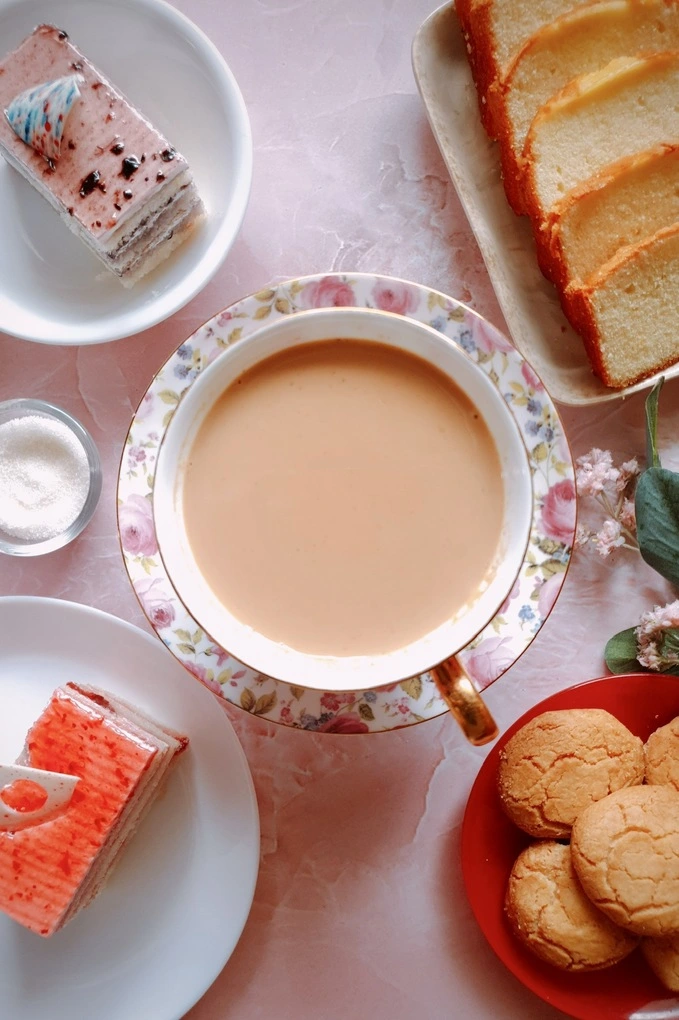
HOW TO MAKE EASY HOMEMADE JAPANESE ROYAL MILK TEA RECIPE USING ONLY 3 INGREDIENTS [Step-by-Step Instructions With Photos]
For exact ingredient measurements and instructions without photos, please scroll down to the Recipe Card.
Hey you, this tea will take you less than 5 minutes to make. It’s a super easy recipe.
Please keep in mind that I go into lots of detail in all my recipes so you get to know all the super important tips and tricks when it comes to making a particular recipe. I always want you to make the BEST of whatever you’re cooking ❤.
So if you’re like oh how to make royal milk tea? You’re in for a treat because this is a deliciously detailed recipe!
I really hope you enjoy this beautiful hot tea.
STEP 1: PUT EVERYTHING TOGETHER
Take a saucepan or a small pot, whatever you prefer.
I’m using a small saucepan here because I’m making just one teacup of Japanese royal milk tea but you can use a bigger saucepan depending on how many cups of tea you’re making.
Pour the milk and water into your saucepan, don’t add the sugar just yet.
Now add in the black tea you’re using.
Give everything a gentle stir.
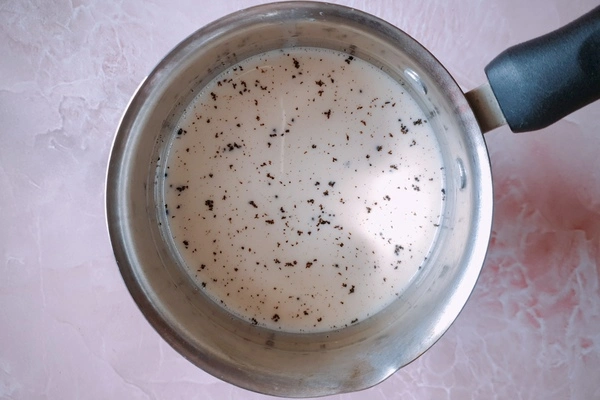
STEP 2: COOK YOUR TEA (Oh yay! 💃🏻)
A small note before you proceed: It’s really important to know here that your tea should NOT come to a boil. It just needs to come to a light bubble. Like the second you see it start to bubble up, switch the heat off instantly. We need to cook our tea just enough to get that incredible tea flavor out and to thicken up the milk just a little into delicious creaminess. Boiling our tea will lead to the tea flavor becoming pretty strong which is a flavor we are not going for in this tea. Literally every extra second your tea cooks for once it reaches a gentle bubble will make it stronger and we don’t want that when making this tea. Boiling is definitely a no-no here.
Now, back to the recipe:
Go ahead and place your saucepan over the stove, switch on the heat and keep it at medium-low heat.
Now wait for your tea to reach a very gentle bubble.
It takes about 3 minutes for my tea to come to a light bubble when the milk is cold and about 2 and a half minutes when the milk is at room temperature but it may vary for you depending on lots of things such as how much tea you’re making, your stove, the saucepan you’re using, how cold your milk and/or water is… etc.
This is just me giving you an estimate. Your tea may come to a gentle bubble even faster than the time I’ve given so just keep a close check.
Also, this is when I’m making one tea cup. When you’re making more than one cup of tea, your tea may take longer to come to a gentle bubble.
So yes, once again, if you’re using cold water, cold milk or both, your Japanese royal milk tea may take longer to come to a light bubble. Please be patient and don’t raise the heat because no matter what, your tea shouldn’t come to a boil.
Go ahead and give your tea a gentle stir halfway while you wait for it to reach a gentle bubble. This is because your tea and milk may sometimes form a layer on top preventing you from seeing any bubbling that may be happening under that layer. So go ahead and break that layer to help that bubbling come through.
Once you see your milk coming to a very gentle bubble, *immediately switch the heat off*.
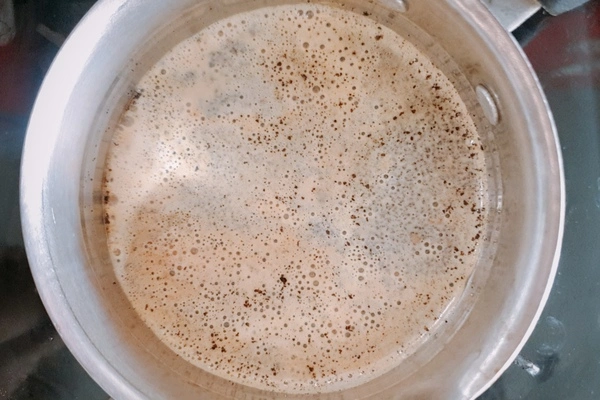
Now cover the saucepan with a lid or plate and let that hot tea rest for 1 minute.
If you’re using an electric cooktop, move your saucepan away from it and place it somewhere else. That’s because the cooktop may still be hot even after switching the heat off.
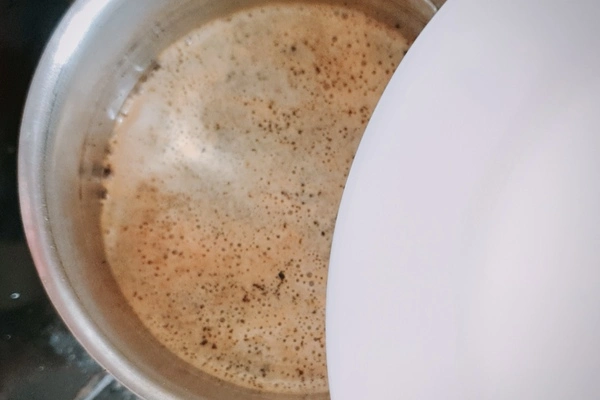
HEY, if you’re making Japanese royal iced milk tea 🧊, let your tea be covered for an extra minute. That’s because as the ice melts, the flavor of the tea may dilute so keeping it a little stronger than usual will help keep that flavor of tea after you make it an iced tea.
So yes…
Once a minute is up, take the lid off and move to the next step.
STEP 3: STRAIN, POUR & ENJOY! ☕
Take your favorite teacup or mug or the most beautiful teacup you have because why even wait for a special occasion when this occasion is special in itself HUH ❤?!
Add the sugar to your teacup.
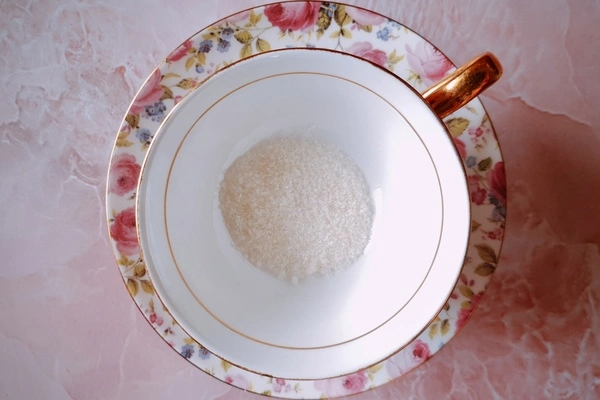
Now, take a small fine mesh strainer, place it over the teacup and pour the tea into the teacup while straining it.
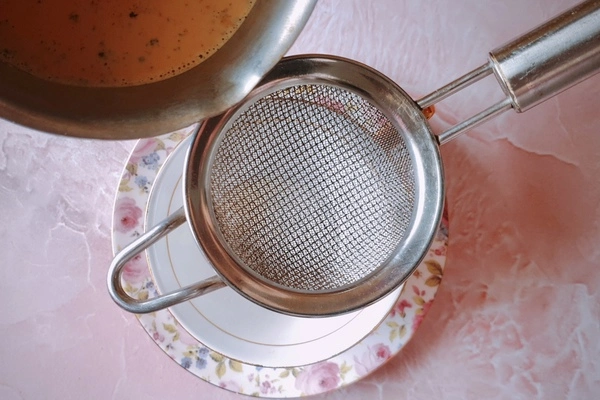
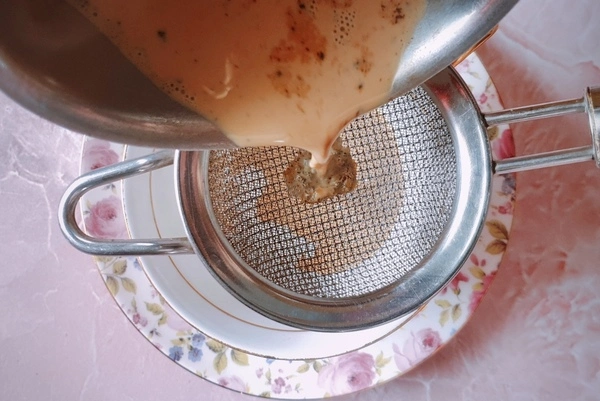
Give your royal milk tea a good stir so the sugar mixes in well with it.
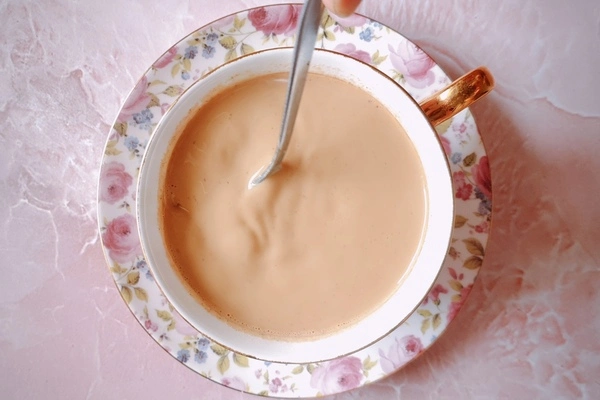
And that’s all! Your Japanese royal milk tea is ready in literally less than 5 minutes.
Go ahead and enjoy your gorgeous delicious creamy milky cup of tea, it tastes absolutely phenomenal 💖.
Hey you, I really hope you love this easy homemade Japanese royal milk tea recipe as much as I do!
If you do, I would appreciate a star rating SO much (you can rate this recipe right below or from the Recipe Card 💖).
Also, if you have any questions about this recipe, make sure to check out our FAQs section below to maybe find your answer there, or leave a comment and I will try to get back to you as soon as possible, I promise 😊.
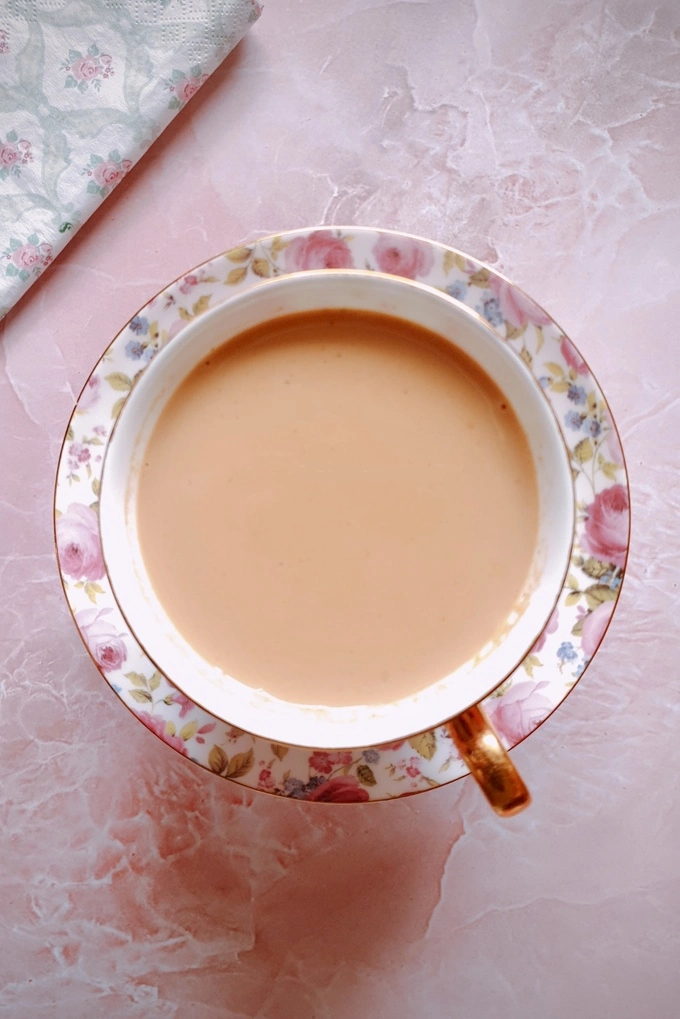
TIPS TO MAKE THE BEST JAPANESE ROYAL MILK TEA
This is a super easy recipe to make but it’s always great to keep a few tips in mind to make the process of cooking this tea even easier! So yep, here we go!
- What black tea to use can be a little confusing when you don’t know what your favorite type of black tea is. The type of black tea you use is pretty important. The most commonly used black teas when making Japanese royal milk tea are Assam tea and Darjeeling tea. Different people have different opinions such as how the tea you use needs to be strong because there’s so much milk and it needs to be able to hold its own so Assam tea is the way to go. And then there are people who prefer the delicate flavor of Darjeeling tea and the gentle touch of flavor it adds to this milky tea. You can read more about these two teas and their flavors here above. Assam tea is my favorite. What I suggest you do is, try making your Japanese royal milk tea with Assam tea as well as Darjeeling tea if you have both and see which tea you prefer! They’re both incredible tasting in their own ways.
- If you feel you prefer certain flavors from both these teas, you can go ahead and make your own custom black tea blend using black tea leaves (loose tea leaves) of these teas! You can mix some Assam tea leaves with Darjeeling tea leaves in the ratio you prefer and see how it turns out. Go ahead and keep experimenting with those black tea leaves, you may just come up with the most perfect black tea flavor ever for yourself. You can make a blend of Darjeeling tea and/or Assam tea with another black tea too such as Ceylon tea! Oh and you don’t have to stick to only Assam tea and Darjeeling tea. You can use other black teas you prefer and to make your own custom blend too. You can also experiment with a completely different type of tea such as Oolong tea.
- So, while I was learning about the different types of black teas out there, I got into how they’re sold in different forms (!) such as whole black tea leaves, CTC tea, tea powder, tea dust… a mix of whole black tea leaves and CTC and so on. I’m not gonna confuse you guys but all I’ll say is go ahead and use some good quality black tea no matter if it’s CTC, black tea leaves… etc. I’ve heard how tea bags don’t really use good quality tea but I’ve also had some very delicious tea that came from tea bags. So yes, all I’ll say is whether you’re using CTC tea, loose leaf tea, tea bags… just get some good quality tea and that’s all, your tea will taste incredible.
- If you’re using loose leaf tea, CTC tea or tea powder and want to skip past the part of straining your tea out while pouring it into the tea cup, you can go ahead and use disposable or reusable tea bags. Just add your tea powder, loose tea leaves or CTC tea (whatever you’re using) to the disposable or reusable tea bags and use those black tea bags to cook your tea.
- Always make sure your tea is kept in an airtight container to keep it as fresh as possible for a long time. This is really important whether you’re using loose tea leaves, CTC tea or tea bags. Fresh tea always tastes good so take care of your tea, you guys!
- If you use cold water, cold milk or both, your Japanese royal milk tea may take a little longer to come to a bubble. Just be patient and don’t raise the heat because no matter what, your tea shouldn’t start boiling, so be careful.
- It’s so important to keep a check on your tea while it cooks. This is such a short recipe, your tea is cooking in the saucepan one minute and before you know it, it’s ready. Please keep a close check on your tea. It should not come to a boil. It just needs to come to a gentle bubble and it’ll take only a few minutes for it to reach that stage. Watch your tea closely while it cooks and don’t let it come to a boil.
- This popular drink is supposed to taste rich and creamy with a gentle flavor from the black tea. To get that perfect cup of delicately flavored Japanese royal milk tea, we barely cook our tea at all so the black tea flavors don’t come in and dominate our tea. If you prefer a slightly stronger cup of tea though, you can go ahead and cook your tea for a longer time. The longer you leave your tea to cook, the stronger it’ll taste. Also, if you lean towards having stronger tea, go ahead and use Assam tea. It has a pretty strong taste especially if cooked for a long time.
- Now, if you want to make some even more gentle flavored Japanese royal milk tea, go ahead and cook it for an even lesser time, like before it even starts to gently bubble and is just heated through in your opinion. If you want to make a cup of tea that’s delicate with a gentle flavor of tea, go ahead and use Darjeeling tea.
- If you’re using an electric cooktop to cook your Japanese royal milk tea, move your saucepan away from it and place it somewhere else in Step 2. That’s because it may still be hot even after switching the heat off and we don’t want our tea cooking any further by that stage.
- If you are making some iced royal milk tea, make sure you leave your royal milk tea to rest for an extra minute in Step 2 when we switch off the heat, cover the tea and leave it to absorb all those amazing flavors. Leaving your tea for that extra minute is important because in an iced milk tea, ice may dilute the tea as it melts. This can make our already gentle delicate tea taste watery. So it’s always best to keep our Japanese milk tea just a little on the stronger side so those flavors don’t get watered down (literally!)!
- Please keep in mind that Japanese royal tea has really gentle flavors of tea and milk so the addition of different sweeteners can influence the taste of this tea quite a bit. So how do you know which sweetener tastes best for you? The best way to find out is to experiment with different sweeteners and see which ones you prefer! Try adding your favorite sweetener in and see how this tea then tastes. Lemme know what sweetener YOU prefer in the comments below ❤ I would love to know.
- How sweet is too sweet? Japanese royal milk tea is supposed to be a sweet tea and I’ve suggested a certain amount of sugar here that Zee and I prefer but if you’re new to adding sugar to your drinks and don’t know your preference, I suggest you just go ahead and add a little sugar, give your tea a taste and keep building it up from there if you want your tea to be sweeter. Keep a check on how much sugar you’re adding though and keep it in mind for the next time you’re adding sugar to a drink. Always remember to start out small with sugar. You can always add more sugar but if your drink gets too sweet, you can’t remove sugar from it.
- So, the sugar always settles down at the bottom of the teacup no matter how much I stir the tea! I suggest you guys go ahead and stir your tea a little more than usual once you add in your sugar so it dissolves well in the tea.
- Hey and if you don’t want to use any sweetener at all and want to skip out on it, you can! Because this tea is so milky, creamy and gentle, thanks to all the milk in it and us cooking the tea for a really short time, it doesn’t taste bitter at all. You can try this Japanese royal milk tea without sugar or any other sweetener and see how you like it.
- Ooh and serve your tea immediately! You can have this milky tea anytime and you can reheat it too BUT tea is always best served nice, hot and fresh. Ah, hot royal milk tea 😍.
- Oh and I know this goes without saying but Japanese royal milk tea fresh out of the saucepan is really hot even though we don’t cook it for a very long time. So no matter how delish that milky hot tea looks, wait a bit for it to cool down a little before taking that first sip. I know this sounds obvious but I just don’t want you burning your tongue because that sucks and this has happened so many times with me because I just can’t control myself around tea :(!
- So, can you make this creamy royal Japanese tea in the microwave? A pretty good question. I think you definitely can BUT it’s always better to just cook it over the stove. That’s because this is a tea with a very delicate cooking process. We need to be able to see the tea coming to a gentle bubble and if your tea is in the microwave, you may not be able to see that easily and every second your tea cooks for over heat after it comes to a bubble will just make it stronger, leaving that delicate flavor we want here!
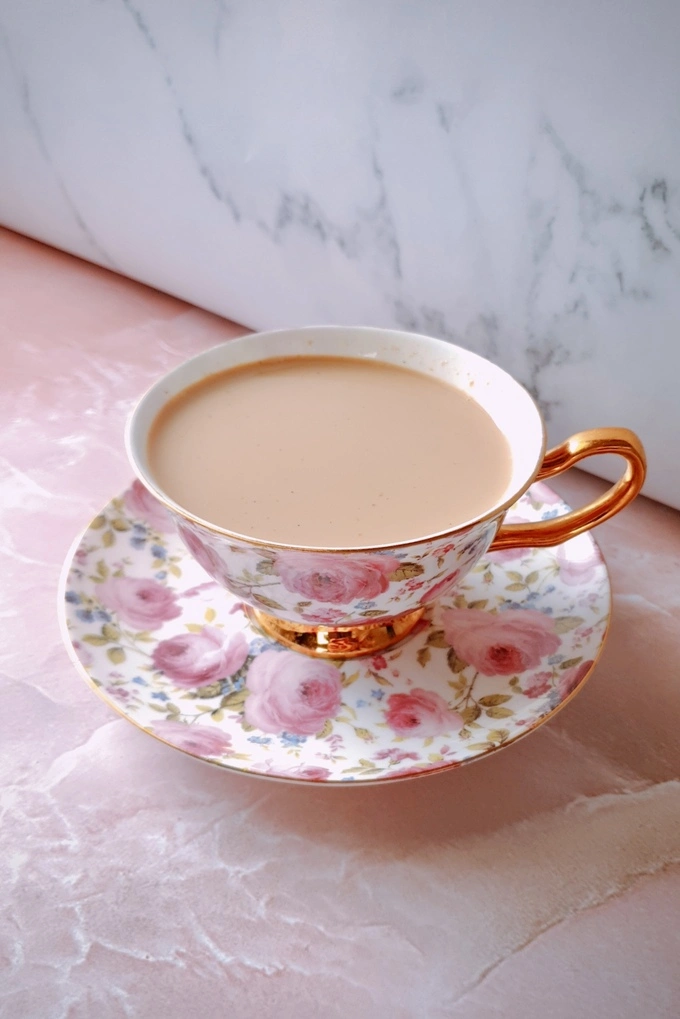
SERVING SUGGESTIONS FOR JAPANESE ROYAL MILK TEA RECIPE
Hello hello HELLO YOU!
This Japanese royal milk tea is so delicious, so good, so incredible that you can just go ahead and have it on its own.
But if you want to serve it along with something else, you very easily can because it goes so well with almost everything out there!
It’s AMAZING.
Let’s discuss a few ideas!
- Make sure you always serve this milky royal Japanese tea immediately. There’s just something about some nice hot Japanese royal milk tea fresh out of the saucepan! Also, if you’re having some iced Japanese royal milk tea, wait for the tea to come to room temperature after it is cooked and serve it immediately once you add the ice cubes to your drink. That’s because those ice cubes will melt and thin out making your milky tea watery if you wait too long.
- I sometimes just go ahead and top my milky tea with a nice fat layer of frothed milk for some extra fun. You can do the same to add to that delicious creaminess of your tea.
- Top your cold or iced royal Japanese milk tea with a scoop of vanilla ice cream (or whatever flavor ice cream you prefer) or whipped cream or both to make it all fancy schmancy! It’ll add to the creaminess of the drink and make it even richer and creamier. To make your Japanese milk tea even fancier and OH so indulgent, go ahead and pour some delicious caramel syrup into your tea instead of sugar, then top it up with some whipped cream or ice cream or both and then top everything up with some more ribbons of caramel sauce or syrup! Ah… this adds so much more richness, creaminess and fun to our creamy milky tea ❤. All those rich extra flavors along with the delicate flavor of tea… whoa.
- You can serve some of your favorite cookies along with this delicious Japanese milk tea too. This tea has a perfect delicate flavor that won’t dominate over other flavors. You can even dip your favorite cookies into this delicious creamy tea and enjoy them as a scrumptious tea time snack! You can go ahead and serve some chocolate chip cookies, peanut butter cookies… oatmeal cookies… homemade matcha cookies? The options are endless! You can serve whatever cookies you absolutely adore with this tea. Oh and shortbread goes along really well with this tea too.
- You can serve small finger sandwiches along with your Japanese royal milk tea as well. I love having some sandwiches along with my tea sometimes. There are so many options out there such as some smoked salmon and cucumber sandwiches, cucumber and mayo sandwiches, tuna and mayo sandwiches, egg salad sandwiches, bread and jam sandwiches, Nutella sandwiches, peanut butter and jelly sandwiches, cheese sandwiches and SO many more… my goodness, I feel like having them all! You can cut them into shapes like circles, triangles, star-shaped or even rectangles! Go ahead and enjoy any of these sandwiches along with your tea, it’s bound to be a good time!
- You can serve something nice and sweet with your Japanese royal milk tea such as some slices of chocolate cake (or whatever flavor you prefer), maybe some fruit tart (or whatever flavor is your fave), muffins… pie, cupcakes, brownies (that combination of chocolate and tea is 💖), macarons, donuts, any pastry you prefer… the list is endless!
- If you’re having this Japanese royal milk tea for breakfast, you can serve it along with some pancakes, waffles, crepes, croissants… Of course you can have these delicious dishes any time too if you want (midnight pancakes ❤!!!).
- You can serve some fresh fruit along with your Japanese royal milk tea too such as strawberries, peaches… kiwis… Whatever you prefer. This delicious drink goes really well with fresh fruit. Dates work so well with tea too! You can also serve some dried fruit along with your tea such as almonds, walnuts or whatever you prefer as well!
- You can also go ahead and serve some Japanese teatime snacks with your creamy Japanese royal milk tea. I’m not an expert by any means but I’ve tried researching and came across these popular teatime snacks in Japan such as rice cakes, daifuku, dorayaki, manju, dango, yokan… and so many more!
- Go ahead and throw a wonderful tea party! Just make some delicious cups of royal milk tea. You can serve this popular drink in some beautiful tea cups and serve some pastries you prefer, sandwiches, cupcakes, slices of cake or Japanese snacks… whatever you prefer along with it. It’s bound to be a success ❤!
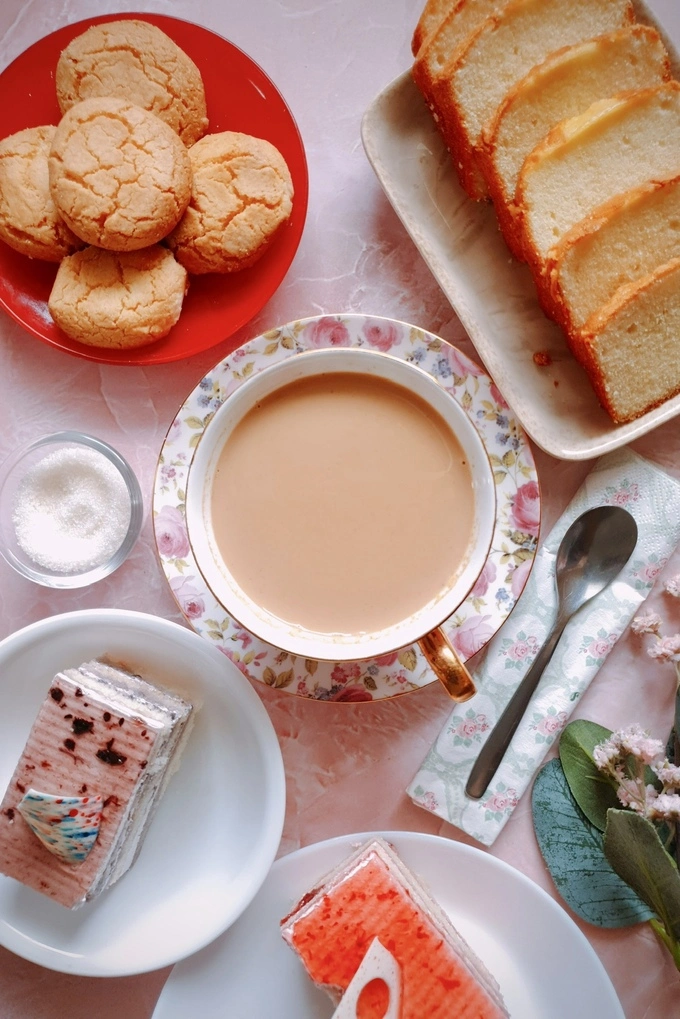
Frequently Asked Questions (FAQs)
What is royal milk tea? Why is it called royal milk tea?
Royal milk tea is a Japanese milk tea that uses whole milk, contains a higher amount of milk than water and is cooked for a really short time, giving us a delicate-flavored tea that is lush, creamy and rich with just a hint of tea flavor.
Compared to a few other milk teas, Japanese royal milk tea tastes mellower and smoother.
It tends to be on the sweeter side as well.
This tea is called Royal Milk Tea because it came into being in 1965, thanks to the tea company Lipton, when they first introduced and created this tea to be a part of the “Royal Tea Recipe Series” in Japan at that time.
It got super famous really fast, thanks to how delicious and unique it tastes.
Japanese royal milk tea is one of the most popular teas in Japan today.
It’s such a popular drink that there are companies (such as Kocha Kaden) selling cans and bottles of this gorgeous drink in Japan.
You’ll literally find royal milk tea bottles and cans in cafes, boba tea shops, restaurants, supermarkets and convenience stores as well as vending machines in Japan today.
Where is Royal milk tea from?
Royal milk tea is from Japan.
It came into existence in 1965, thanks to the tea company, Lipton, when they first introduced and created it to be a part of the “Royal Tea Recipe Series” in Japan at that time.
What’s in royal milk tea?
Putting it simply, there is water, black tea and milk (usually whole milk) along with a sweetener (such as sugar) in royal milk tea.
This is such a simple recipe because it doesn’t have any difficult to find ingredients at all. You probably already have all these ingredients at home and even if you don’t, you can easily find them at your local grocery store.
What does royal milk tea taste like? What flavor is royal milk tea?
Royal milk tea is creamy and sweet with a gentle flavor of tea.
It’s creamy thanks to the whole milk and leans towards being slightly sweet thanks to the sugar.
The creaminess of the milk and the sweetness from the sugar help balance out the already delicate flavor of the black tea (thanks to not letting it cook too much) giving us a milk tea that is sooo creamy and sweet with a super gentle touch of tea.
So good. You just need to try it ✨!
Royal milk tea has flavors that are similar to Indian chai. It tastes like a super mild, sweet and creamy version of Indian chai without the spices that are sometimes added to a chai.
Is royal milk tea sweet?
Yes, royal milk tea is on the sweeter side.
This is a gentle milk tea with really delicate flavors of black tea and some nice fatty milk.
The sweetness from the sugar adds to the balance of this milk tea and makes everything come together really well.
All those different flavors just work so well together, giving us a sweet, creamy delicious drink.
Does royal milk tea have caffeine?
Yes, Japanese royal milk tea does contain caffeine.
Black tea contains caffeine and since we use black tea in Japanese royal milk tea, this is where the caffeine comes from.
The amount of caffeine will vary depending on the type of black tea you use, the age of that black tea, how long you cook it for… etc.
How is royal milk tea different from milk tea? What is the difference between milk tea and royal milk tea?
The main difference between royal milk tea and milk tea is that royal milk tea uses whole milk, contains more milk than water compared to regular milk tea, has everything (water, milk and tea) cooked together in a saucepan over the stove and is also cooked for a really short time.
Please keep in mind that here I’m comparing royal milk tea to regular commonly-known milk tea where the tea is left to steep in a small pot of water first and then is poured into cups and has milk added separately to it.
Milk tea means tea that has milk added to it. It’s an umbrella term and there are different types of milk teas out there in the world changing from country to country and literally even region to region in each country.
Milk tea recipes in my country change from family to family even!
I’m comparing royal milk tea to regular commonly known milk tea because this type of milk tea is widely known out there so it’ll be easier to understand what makes royal milk tea different.
Royal milk tea is a type of milk tea.
To learn more about the differences between royal milk tea and commonly known regular milk tea, as well as to know about some other different types of milk tea that exist out there in the world, go ahead and check this out- Japanese Royal Milk Tea vs Milk Tea: A Unique Guide!
Is royal milk tea healthy for you? What are some benefits of royal milk tea?
Japanese royal milk tea is a bit of an indulgent drink thanks to the fatty milk and sugar we use but it does have some pretty good health benefits too!
The milk has loads of benefits on its own that I won’t discuss here because this answer may get way too long.
There are so many benefits from the black tea too that I’ll discuss in brief here!
Black tea is filled with antioxidants and lots of good stuff. It’s said to help reduce cholesterol, blood pressure, blood sugar levels and is also said to lower the risk of having a heart attack, heart disease and stroke. Having black tea can also reduce the risk of some cancers.
Also, because black tea contains caffeine and an amino acid called L-theanine, it can help improve focus and energy while helping you remain calm and relaxed.
Black tea has lots more benefits you can go and read about, just another reason why this royal milk tea is super amazing!
Can royal milk tea be refrigerated?
Yes, you can refrigerate royal milk tea if you’re planning on having it later.
You can go ahead and heat it whenever you want to have it.
This popular drink doesn’t always have to be reheated though. You can just go ahead and have some cold royal milk tea or even iced royal milk tea by adding some ice cubes to your already cold royal milk tea.
Your royal milk tea will last about 3 days in the fridge.
Royal Milk Tea vs Brown Sugar Milk Tea
I can understand where the confusion comes from between these two because both these drinks are pretty sweet and milky and also most of the time have boba pearls (especially in brown sugar milk tea) added to them.
But there are quite a few differences between them.
Origin:
- Royal milk tea originated in Japan.
- Brown sugar milk tea originated in Taiwan, China.
Tea:
- Royal milk tea contains black tea.
- Brown sugar milk tea on the other hand contains no black tea or any tea at all!
Ingredients and method of cooking:
- Royal milk tea contains water, sugar, black tea and whole milk. It uses a higher amount of milk than regular commonly known milk tea. The method of making this tea varies but most commonly, everything is cooked together in the same saucepan until it comes to a slight bubble and the heat is then switched off immediately. This cooking process is followed so that the milk thickens up nice and good and also so the milk tea has a gentle delicate flavor of tea.
- Brown sugar milk tea contains brown sugar, tapioca pearls, water and milk. The method of making this tea varies from one recipe to the other but usually, brown sugar syrup is poured down the sides of the cup giving this drink the famous name, tiger milk tea because of those brown sugar syrup stripes. Boba pearls soaked in brown sugar syrup are then added to the cup and milk is poured on top. The drink is then usually topped with some heavy cream.
Sweetener:
- Different places selling royal milk tea add different sweeteners to it. Some places add in some sugar, some add brown sugar, some add sugar syrup and so on.
- Brown sugar milk tea on the other hand uses brown sugar syrup as a sweetener.
Hot or cold:
- Royal milk tea is usually had hot, cold or iced.
- Brown sugar milk tea on the other hand is almost always had cold or iced.
Tapioca pearls (Boba):
- Royal milk tea doesn’t always contain tapioca pearls. Sometimes, in iced versions of this tea, tapioca pearls are added in.
- Brown sugar milk tea almost always contains tapioca pearls. It’s one of the most famous types of boba teas in the world!
Royal Milk Tea vs Pearl Milk Tea
Royal Milk Tea:
- It’s a type of milk tea that contains more milk than regular milk tea.
- It’s also necessary to use whole milk so the tea is rich and creamy.
- In this tea, the water, black tea and milk is cooked together and it’s also cooked for a really short time to get just a little flavor of the tea out and thicken up the milk a bit. The result is a sweet creamy milk tea with a deliciously delicate flavor of black tea.
Pearl Milk Tea:
- Pearl milk tea is another name for bubble tea and boba tea.
- There are loads of different flavors of it out there in the world. Royal milk tea can be called a type of pearl milk tea too if you make a nice cold or iced version of it and add boba pearls to it… a delicious royal milk bubble tea!
Can this royal milk tea recipe be made ahead of time? How do I store it and how long will it last in the fridge?
Yes, you can make this royal milk tea recipe ahead of time. It’s a pretty simple process too.
Just go ahead and cook the tea as given in the recipe here. Then leave it to cool.
Once it’s cooled down, transfer it to an air-tight container and keep it in the fridge.
It will last for about 2 to 3 days.
You can then have it cold, iced or hot.
It’s pretty simple to reheat this royal milk tea. Whenever you’re having it, just pour it into a cup or mug and heat it in the microwave or in a small saucepan over the stove until it’s heated through. And that’s all ❤!
Can I make this easy homemade Japanese royal milk tea recipe using 3 ingredients according to my diet preference?
Yep, you can make this delicious royal milk tea recipe according to your diet preference!
Explore the Variations Section above to see our suggestions on how you can make the dairy-free and vegan versions of this homemade Japanese royal milk tea recipe using 3 ingredients.
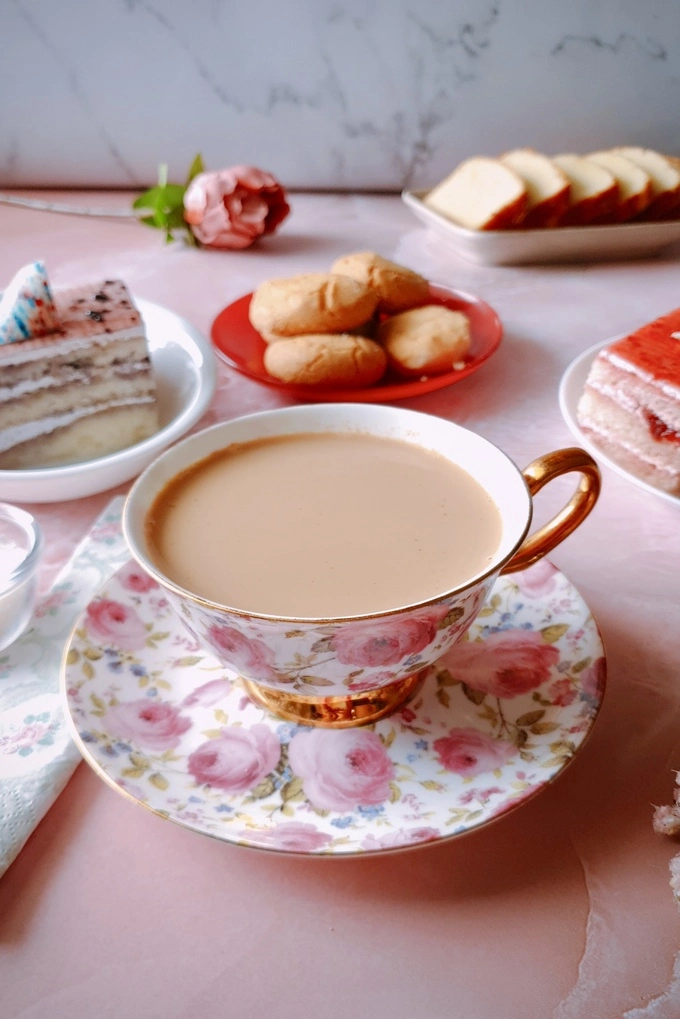
❤❤❤
Hey you, I really hope you love this easy homemade Japanese royal milk tea recipe as much as I do!
If you do, I would appreciate a star rating SO much (you can rate this recipe right below or from the Recipe Card 💖).
We would love to get to know you better, say hello in the comments below ❤.
Don’t forget to Subscribe to our Newsletter for more personalized conversations and exclusive interactions.
Also, keep in touch and follow us on Pinterest, Instagram and Facebook!
If you make this recipe, please post a picture of it and tag me on Pinterest or Instagram @thebutteryfairytale. You can also hashtag it with #thebutteryfairytale. I LOVE seeing your recipe creations and seeing you create our recipes is… the best feeling in the whole world! 😊💖
Would you like to explore more such recipes? Check out our collection of super delicious Drinks & Smoothies, Soups & Stews and Winter recipes.
EASY Homemade Japanese Royal Milk Tea Recipe: 3 ingredients!
Ingredients
- 60 ml or ¼ cup water …please keep in mind that these measurements are for one teacup. For every extra cup of tea you make, just reduce about 10ml or 1 tbsp from the total amount of water you need to use (eg. from 120 ml for 2 cups of tea, reduce 10 ml and use 110 ml water, from 180 ml for 3 cups of tea, reduce 20 ml and use 160 ml and so on…)
- 120 ml or ½ cup whole milk (can substitute with any milk of your choice but the fattier and creamier it is, the better!)
- 1½ tsp Assam tea or 2 teabags… I prefer Assam tea but you can substitute with any black tea of your choice, to understand better, check this section out above
- 2 tsp sugar go ahead and adjust according to your preference (can substitute with any sweetener of your choice)
( Note- Please keep in mind that I go into lots of detail in all my recipes so you get to know all the super important tips & tricks when it comes to making a particular recipe. I always want you to make the BEST of whatever you’re cooking ❤ )
Instructions
- PUT EVERYTHING TOGETHERTake a saucepan.I’ve used a small saucepan here because I’m making just one teacup of Japanese royal milk tea but go ahead and use a bigger saucepan if you’re making lots of cups of tea.Now pour 120 ml or ½ cup whole milk.Then pour in 60 ml or ¼ cup water (this measurement is for one teacup. For every extra cup of tea you make, remove 10 ml or 1 tbsp of water each) into your saucepan.Don't add the sugar yet.And add in 1½ tsp Assam tea.Give everything a gentle stir.
- COOK YOUR TEA (Woohoo 💃🏻)(Just a small heads up here before you proceed: It’s really important to know here that your tea should NOT come to a boil. It just needs to come to the lightest bubble. The second you see your tea come to a gentle bubble, switch the heat off immediately. The tea shouldn’t come to a boil. Boiling it will lead to the tea flavor becoming pretty strong which is a flavor we are not going for in this tea.)Now, back to the recipe:Go ahead and place your saucepan over the stove, switch on the heat and keep it at medium-low heat.Now you need to wait for your tea to reach a very gentle bubble. It takes about 3 minutes for my tea to come to a light bubble when the milk is cold and about 2 and a half minutes when the milk is at room temperature BUT it may vary for you depending on lots of things such as how much tea you’re making, your stove, the saucepan you’re using, how cold your milk and/or water is… etc.This is just me giving you an estimate. Your tea may come to a gentle bubble even faster than the time I’ve given so just keep a close check on it ❤.Also, this is when I’m making one cup of tea. When you’re making more than one cup, your tea may take longer to come to a gentle bubble.So yes, once again, if you’re using cold water, cold milk or both, your Japanese royal milk tea may take longer to come to a bubble. Please be patient and don’t raise the heat because no matter what, your tea shouldn’t come to a boil. You can give the tea another very gentle stir halfway while you wait for it to reach a gentle bubble.This is because your tea and milk may sometimes form a layer on top preventing you from seeing any bubbling that may be happening under that layer. So go ahead and break that layer to help that bubbling come through.Once you see your milk coming to a light bubble, switch the heat off immediately and cover the saucepan with a lid or plate for 1 minute.If you’re using an electric cooktop, move your saucepan away from it and place it somewhere else.That’s because the cooktop may still be pretty hot even after switching the heat off and we don’t want that heat continuing to cook our tea.Every extra second your tea cooks for once it reaches a gentle bubble will make it stronger and we don’t want that when making this tea.Tip: If you’re making Japanese royal iced tea, let your tea be covered for an extra minute. That’s because as the ice melts, the flavor of the tea may dilute a bit so keeping it a little stronger than usual will help keep that flavor of tea.So yes…Once a minute is up, take the lid off and move to the next step.
- STRAIN, POUR AND ENJOY ☕Take your favorite teacup or mug or the most beautiful teacup you own, whatever you prefer ❤Add 2 tsp sugar to your teacup.Then take a small fine mesh strainer, place it over the teacup and pour the tea into the teacup while straining it.Give your royal milk tea a nice good stir.And there you go! Your Japanese royal milk tea is ready in literally less than 5 minutes.Go ahead and enjoy your gorgeous delicious cup of creamy milky tea 💖 It tastes incredible.
Notes ✍🏼
- What black tea to use can be a little confusing when you don’t know what your favorite type of black tea is. The type of black tea you use is pretty important here when making this delicious drink. The most commonly used black teas when making Japanese royal milk tea are Assam tea and Darjeeling tea. Different people have different opinions such as how the tea you use needs to be strong because there’s so much milk and it needs to be able to hold its own so Assam tea is the way to go and then there are people who prefer the delicate flavor of Darjeeling tea. You can read more about these two teas and their flavors here above and make up your mind. Assam tea is my favorite. What I suggest you do is, try making your Japanese royal milk tea with both Assam tea as well as Darjeeling tea and see which tea you prefer! They’re both incredible tasting in their own ways.
- If you feel you prefer certain flavors from both Assam tea and Darjeeling tea, go ahead and make your own custom black tea blend! You can mix some Assam tea leaves with Darjeeling tea leaves in the ratio you prefer and see how it turns out. Go ahead and keep experimenting, you may just come up with the most perfect black tea flavor ever. Oh and you can use other black teas you prefer such as Earl Grey or Ceylon tea, etc… when making Japanese milk tea as well to make your own custom blend. You don’t have to stick to only Assam tea and Darjeeling tea. You can also experiment with a completely different type of tea such as Oolong tea.
- I was recently reading about the different types of black teas out there, and I got into how they’re sold in different forms (!) such as whole black tea leaves, CTC tea, tea powder, tea dust… a mix of whole black tea leaves and CTC and so on. I’m not gonna confuse you guys but all I’ll say is go ahead and use some good quality black tea. I’ve heard how tea bags don’t really use good quality tea but I’ve also had some amazing tea that came from tea bags.
- If you’re using black tea leaves, CTC tea or tea powder and don’t want to go through straining your tea while pouring it into the tea cup, you can use disposable or reusable tea bags. Just fill the tea bag with your tea powder, black tea leaves or CTC tea (whatever you’re using), add those black tea bags to the milk and water in the saucepan and cook your tea.
- Always make sure your tea is nice and fresh by storing it in an airtight container. This is super important because fresh tea always tastes good so take care of your tea, you guys!
- If you use cold water, cold milk or both, your Japanese royal milk tea may take longer to come to a gentle bubble. Please be patient and don’t raise the heat because no matter what, your tea shouldn’t come to a boil.
- It’s really important to keep a check on your tea while it cooks. This is such a short and quick tea recipe, your tea is cooking in the saucepan one minute and before you know it, it’s ready. Please keep a close check on your tea. It should not come to a boil. It just needs to come to a gentle bubble and it’ll take only a few minutes for it to reach that stage.
- Because Japanese royal milk tea is supposed to taste rich and creamy with a gentle flavor from the black tea, we barely cook our tea at all so those black tea flavors don’t get really strong and dominate over our tea. If you prefer a slightly stronger tea though, you can go ahead and cook your tea for a longer time. The longer you leave your tea to cook, the stronger it’ll taste. You can also use Assam tea if you prefer strong tea. It has a pretty strong flavor especially when cooked for a long time.
- Now, if you want your Japanese royal milk tea to have an even gentler flavor, go ahead and cook it for a much lesser time, like before it even starts to gently bubble and is just heated through in your opinion. If you want to make your tea delicate with a gentle flavor of tea, go ahead and use Darjeeling tea.
- If you’re using an electric cooktop, move your saucepan away from it and place it somewhere else in Step 2 after switching the heat off. That’s because it may still be hot even after switching the heat off and we don’t want our tea cooking any further by that stage.
- When making iced royal milk tea, make sure you leave your royal milk tea to rest for an extra minute in Step 2 when we switch off the heat and cover the tea. Leaving your tea for that extra minute is important because in iced milk tea, ice cubes may dilute the tea as they melt. This can make our already gentle delicate tea taste watery. So it’s always best to keep our Japanese milk tea just a little on the stronger side so those flavors don’t get watered down (literally! 😱) and you can enjoy a delicious creamy iced tea!
- Please keep in mind that Japanese royal tea has really delicate flavors of tea and milk so the addition of different sweeteners may influence the taste of this tea quite a bit. So how do you know which sweetener tastes best for you? The best way to find out is to experiment with different sweeteners out there and see which ones you prefer! Lemme know what sweetener YOU prefer in the comments below ❤.
- So, how sweet is too sweet? Japanese royal milk tea is supposed to be on the sweeter side and I’ve suggested a certain amount of sugar here that we prefer here but if you’re new to adding sugar to your drinks and don’t know how much you prefer, I suggest you just go ahead and add a little sugar, give your tea a taste and keep building it up from there if you want your tea to be sweeter. Keep a check on how much sugar you’re adding and keep it in mind the next time you’re adding sugar to a drink. Always remember to start out small with sugar. You can always add more sugar to your drink but if it gets too sweet, you can’t remove sugar from it.
- So, sugar always settles down at the bottom of the teacup no matter how much I stir the tea! I suggest you stir your tea a little more than usual so the sugar dissolves really well.
- Oh and if you want to skip out on sweetener, you can! That’s because this tea is super milky, creamy, gentle and not bitter at all thanks to all the milk in it and us not cooking the tea for too long. You can try this Japanese royal milk tea without sugar or any other sweetener and see how you like it.
- Ooh and please serve your tea immediately. You can have this milky tea anytime BUT tea is always best served nice, hot and fresh ⭐.
- And I know this goes without saying but Japanese royal milk tea fresh out of the saucepan is really hot even though we don’t cook it for a really long time. So hey you, no matter how deliciously amazing that milky hot tea looks, wait a little for it to cool down a bit before taking that first sip. I know this sounds obvious but I just don’t want you burning your tongue because that sucks and has happened so many times with me because I just can’t control myself around tea :(!
- Can you make Japanese royal milk tea in the microwave? That’s a pretty good question. I think you definitely can make this delicious drink in the microwave BUT it’s always better to just cook it over the stove. That’s because this tea has a very delicate cooking process. We need to be able to see our tea coming to a gentle bubble and if your tea is in the microwave, you may not be able to see that happen easily and every second your tea cooks for over heat once it comes to a bubble will just make it stronger, leaving that delicate flavor we want here!
- One of the main ingredients that make this tea taste so *fine* is some good whole milk. That creamy richness of a fatty milk is the absolute best ❤. You can use some whole milk as I’ve mentioned or even half and half for an even creamier taste. You can also use evaporated milk/ unsweetened condensed milk along with whole milk to add to that thickness and creaminess. You can go ahead and use your favorite lactose-free or plant-based milk that you feel is creamy too (check here for dairy-free and vegan options).
- To add some fun to your warm Japanese royal milk tea, go ahead and top it up with a fat layer of frothed milk. If you’re feeling a little more indulgent and feel like pampering yourself a bit, go on and top your decadent warm royal milk tea with some whipped cream. Ah 💖
- Because this royal Japanese creamy milk tea is supposed to taste rich and creamy with a gentle flavor from the black tea, we don’t cook our tea much at all. If you prefer a stronger tea though, you can go ahead and cook your tea for a longer time. The longer you cook your tea, the stronger it’ll get. You can also use Assam tea if you prefer strong tea. It has a pretty strong flavor especially when cooked for a long time.
- Now, if you want your Japanese royal milk tea to have an even gentler flavor, just cook it for a much lesser time, like before it even comes to a gentle bubble and is just heated through in your opinion. You can also use Darjeeling tea if you want to make your tea even more delicate with a gentle flavor. Darjeeling tea has a pretty mild flavor.
- The addition of different sweeteners can change the taste of a drink quite a bit, especially when it’s a drink as gentle-flavored as Japanese royal milk tea. I prefer white sugar as a sweetener here in this Japanese drink but you can go ahead and experiment with different sweeteners out there and see which ones you like best. A few ideas are sweetened condensed milk (for some even creamier sweet goodness), caramel syrup (for a sweet rich smoothness), honey (for a sweet silky floral touch! Please keep in mind that the flavor of honey is important here and will change the flavor of your tea too!) brown sugar (for a delicious candy toffee-ish taste. You can make some brown sugar syrup for even more richness). You can also use maple syrup, coconut sugar, agave… you can make some sugar syrup too using any sugar you prefer.
- There’s a famous brand in Japan that sells ready to make Japanese royal milk tea. It sells royal milk tea powder in flavors such as peach and strawberry. You can make a sweet fruit syrup to add to your royal milk tea for sweetness and a fruity flavor as well. Go ahead and buy a fruit syrup or make your own fruit syrup at home using your favorite fruit and just add it to your royal milk tea once it’s ready!
- Oh hey, if you want to skip out on using a sweetener, you can try and see how you like the taste of this tea without a sweetener. When it comes to a milky creamy tea like this where the tea isn’t cooked for really long, it won’t taste really bitter and also, thanks to all the milk, it’ll be super creamy. You can skip out on a sweetener and see how you like the taste of this tea.
- You can have this milk tea cold too! It tastes super delicious and refreshing. You can also add in some ice cubes and make it a Japanese royal milk iced tea! Chilled cans and bottles of royal milk tea are sold in vending machines in Japan. You’ll even get iced or cold versions of royal milk tea boba ❤. This creamy drink works so well hot, cold and iced!
- You can add a fancy touch to your cold or iced royal Japanese milk tea by topping it with some ice cream or whipped cream or both! It’ll just add to the already existing creaminess and richness of this drink. To make things even fancier, pour some delicious caramel sauce or syrup into your tea instead of sugar, then top the tea up with some whipped cream or ice cream or both and then top it all up with some more ribbons of caramel sauce or syrup! YUM! This adds so much more indulgence and creaminess to this delicious delicious (!) milky tea ❤.
- You can add to the flavor of this Japanese royal milk tea and make it taste even richer by adding in a few strands of saffron to the tea while it cooks. You can also add in a few whole spices such as cloves, cardamom, cinnamon… to get that earthy flavor that Indian chai has but in a really mild form here because here we won’t be cooking our tea much. We’ll get in just a hint of flavor of these spices without them being overpowering. You can add in some ginger too while the tea cooks for added flavor because it goes so well with milk tea ❤. These extra ingredients will add to the health benefits and taste of this tea.
- You can try making Hokkaido milk tea which is a type of Japanese royal milk tea found in the Japanese prefecture, Hokkaido. Hokkaido milk is used in this tea which is a delicously fatty milk with a slight hint of vanilla. Finding Hokkaido milk outside Japan can be pretty tough. If you happen to have any with you after a recent visit, you can use it OR you can go ahead and try making something close to it. Just take some full-fat milk, you can add some cream to it too to make it even fattier. Add a small drop of vanilla extract or just a little vanilla bean paste to it, mix it well and cook your tea according to our recipe here! Hokkaido milk tea also usually uses a sweetener called Sanonto sugar which is a light brown type of brown sugar. You can also use brown sugar, demerara sugar, honey or caramel syrup instead.
- You can also try making some Okinawa milk tea. This is another type of Japanese royal milk tea found in the Japanese prefecture, Okinawa. What makes this tea different is that it uses a sweetener called Kokuto sugar. This is a type of brown sugar produced in Okinawa and it has a pretty distinct taste. Kokuto sugar may not be easy to find outside Japan and if you don’t have any at home, you can go ahead and use brown sugar, palm sugar or toast your sugar a little and add it to the tea you’ve prepared according to our recipe here.
- Since this is a delicate-flavored rich milky tea, the creamy flavors of it go super well with tapioca pearls. Just go ahead and add some boba pearls to this rich tea and make it a Japanese royal boba milk tea ❤. Ah, bubble tea is one of the best things in the whole world and this tea makes a deliciously decadent bubble tea.
- Lots of people love the color of tea. I for one adore the color of Indian chai, it’s one of the prettiest colors ever. Some people also prefer to have the color of their drink be lighter or darker depending on the type of drink they’re making and the look they’re going for. If you would like to go for a lighter colored Japanese royal milk tea, go ahead and use Darjeeling tea. The tea will be a light very pretty creamish-light brown color. If you want a darker colored Japanese royal milk tea, go ahead and use Assam tea. The color will be a beautiful lightish-medium brown and will darken the more you cook it.
Nutrition (per serving)
The nutritional information given here is only an estimate.
Please read our full Nutrition Information Disclaimer to learn more.Did you make this recipe?
I adore going through your creations! Tag us @thebutteryfairytale and hashtag it #thebutteryfairytale on Instagram.

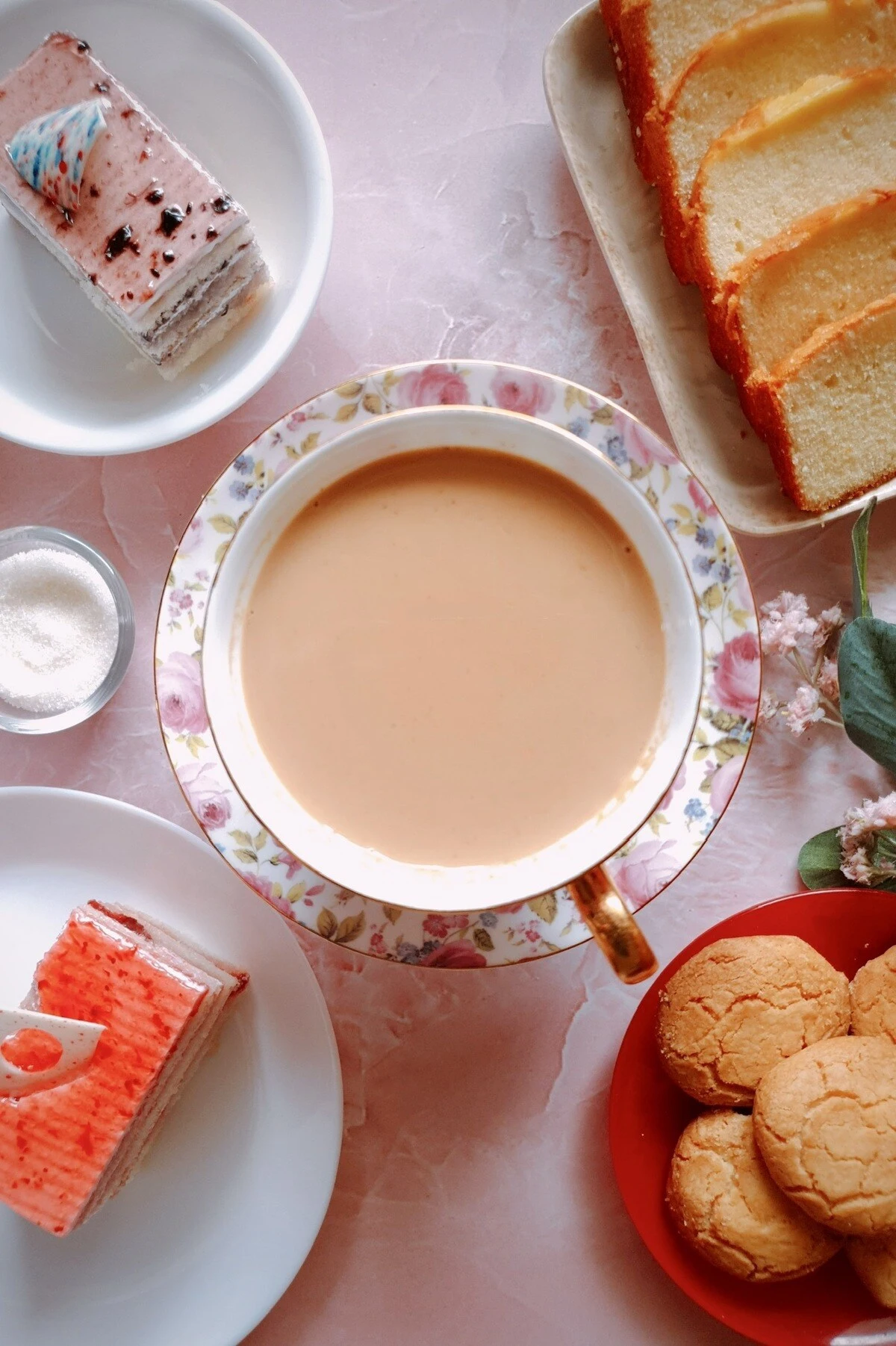
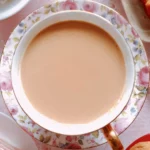
I’m blown away by how something so simple can taste this good. I had no idea something called Japanese royal milk tea even existed before this! The creamy texture of this tea is something i haven’t ever experienced before. Spectacular!
As a massive lover of milk tea, I couldn’t believe I never tried Japanese royal milk tea before too. I just hadn’t ever heard of it… So glad I know about it now! The flavor and texture is out of this world. I’m so glad you enoyed it, Will!
I have always had regular milk tea and recently tried this Japanese royal milk tea because I just love milk tea so much. This is so much easier to make and tastes fantastic… Such a delicious creamy milk tea. Thank you for introducing me to something new. Lots of love xx
Thank you for so much for your kind words, Rachel. I’m so glad you enjoyed this delicious milk tea. I’m so in love with it too, it’s become one of my most favorite milk teas ever! Loads of love back right back at you ❤.